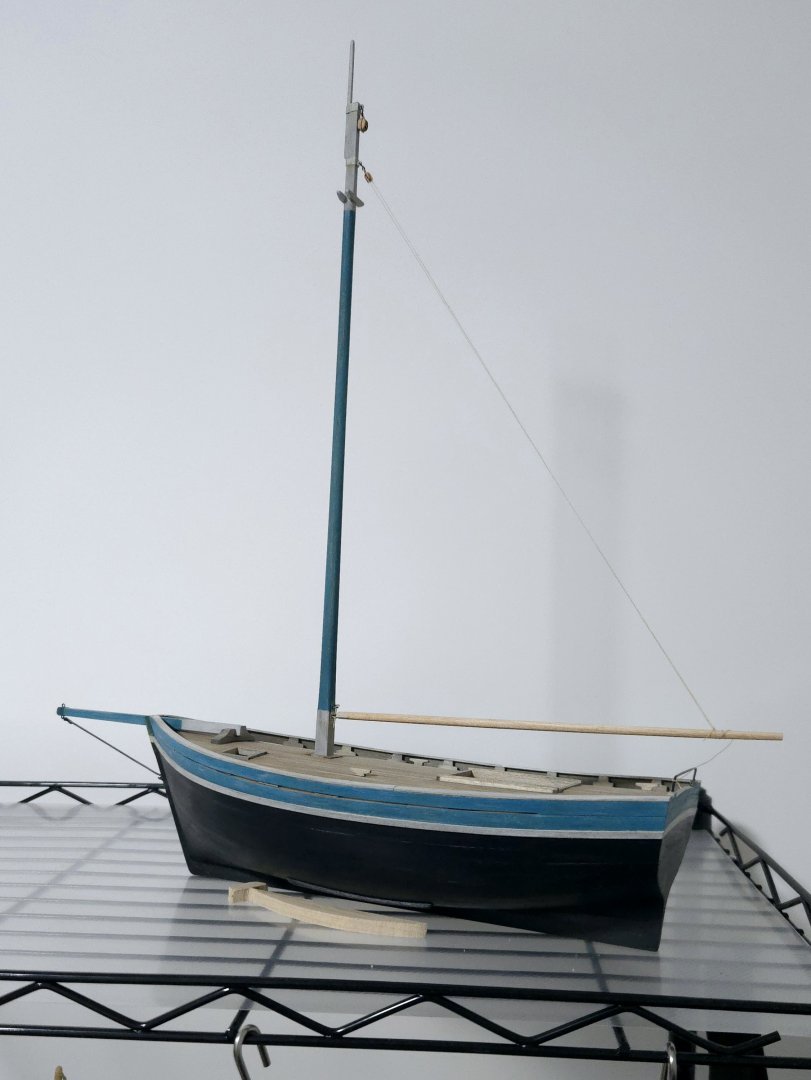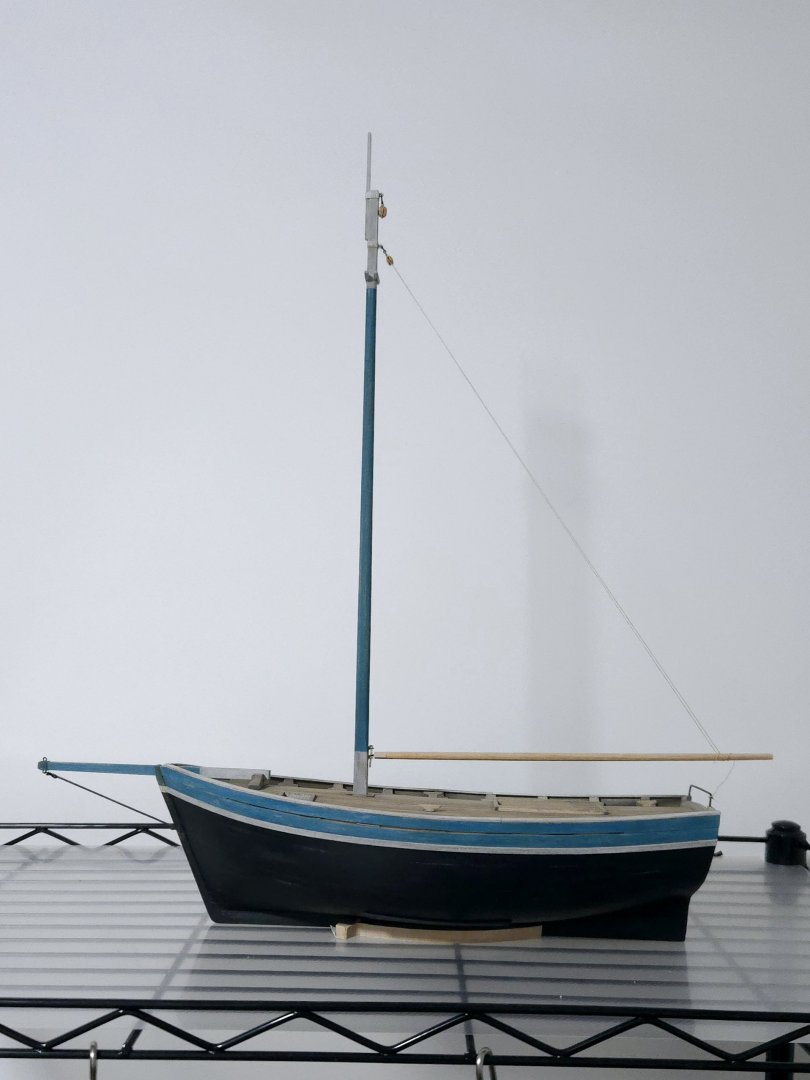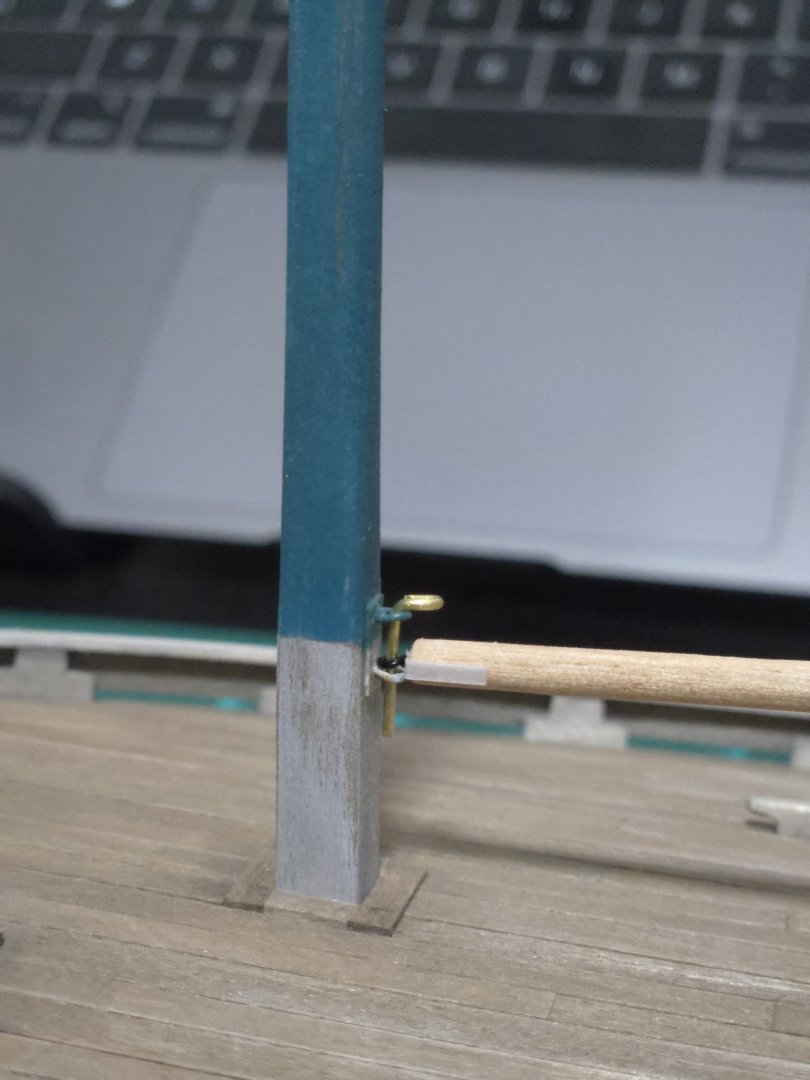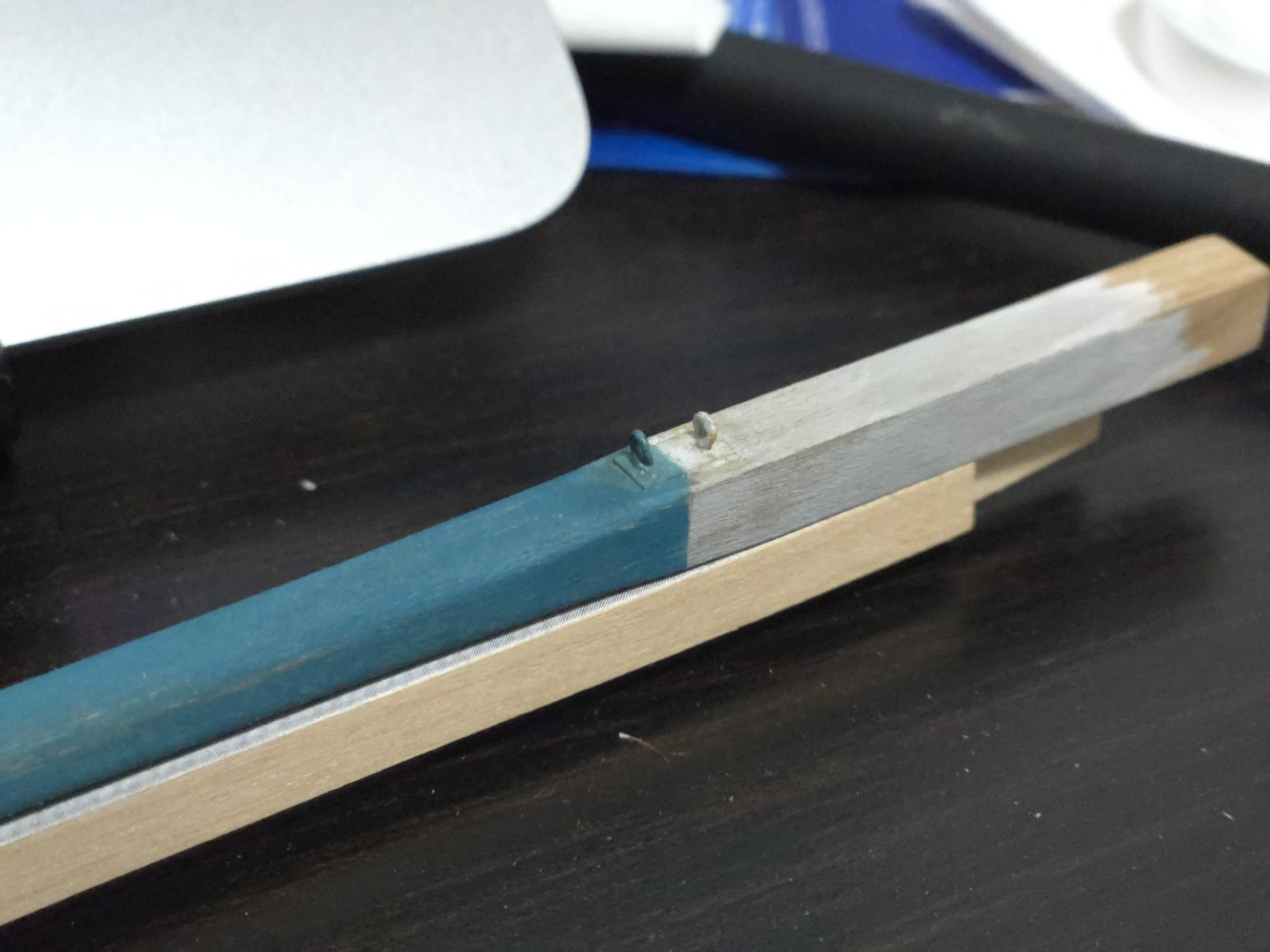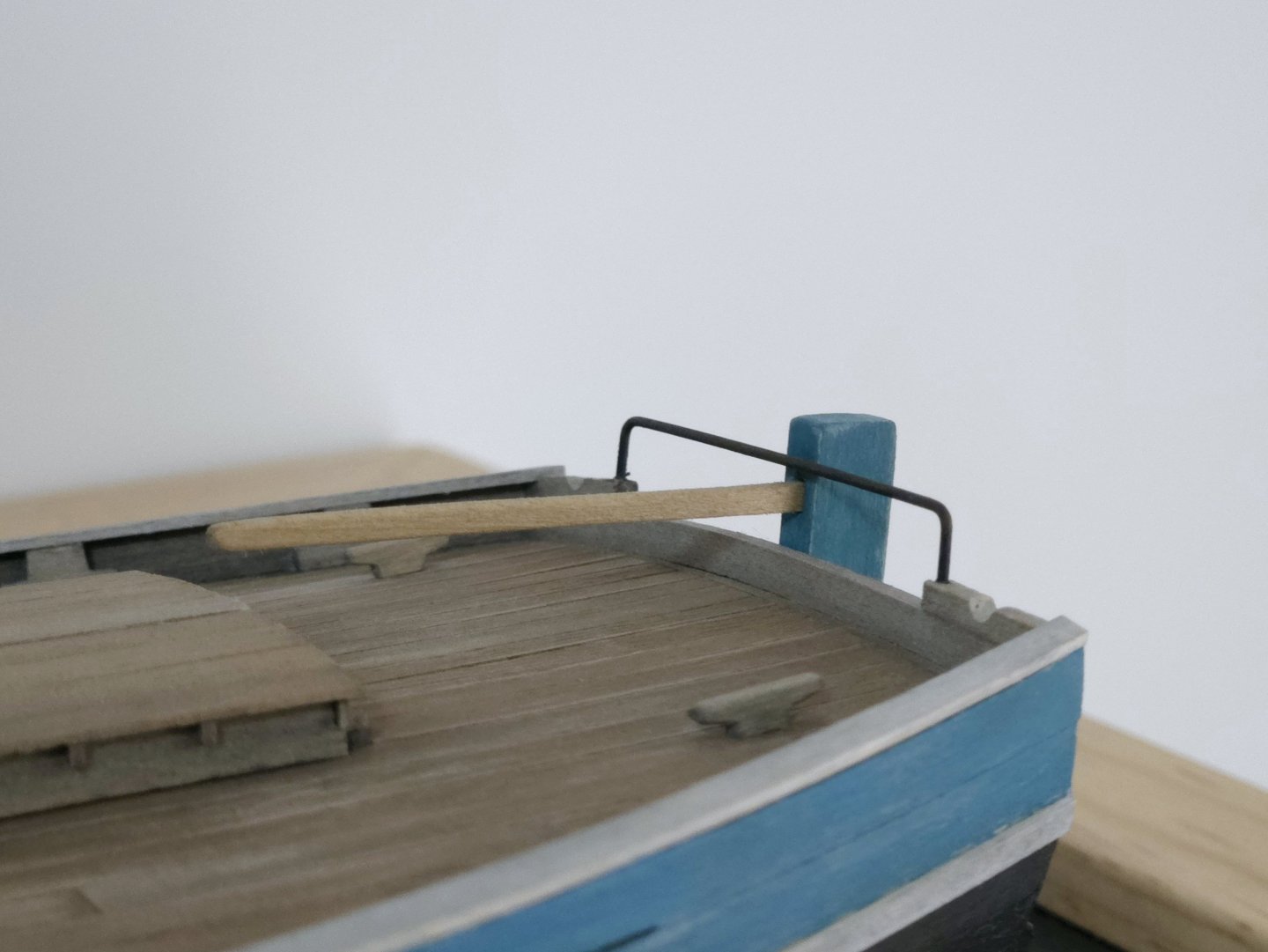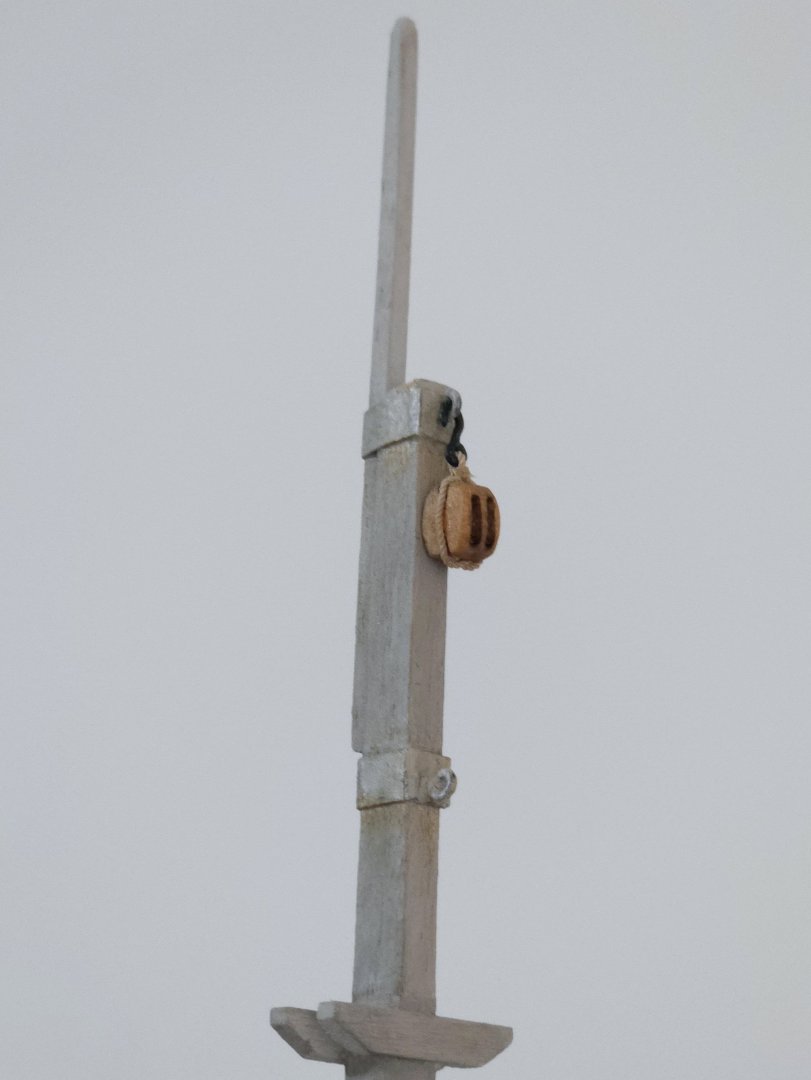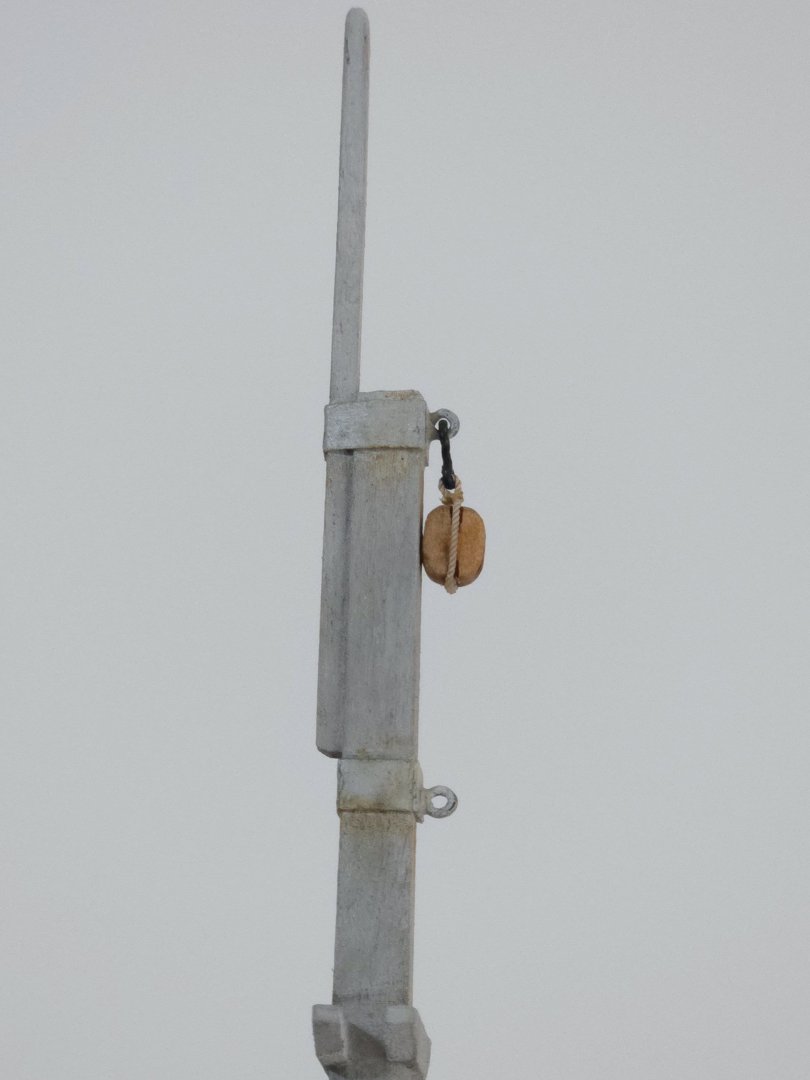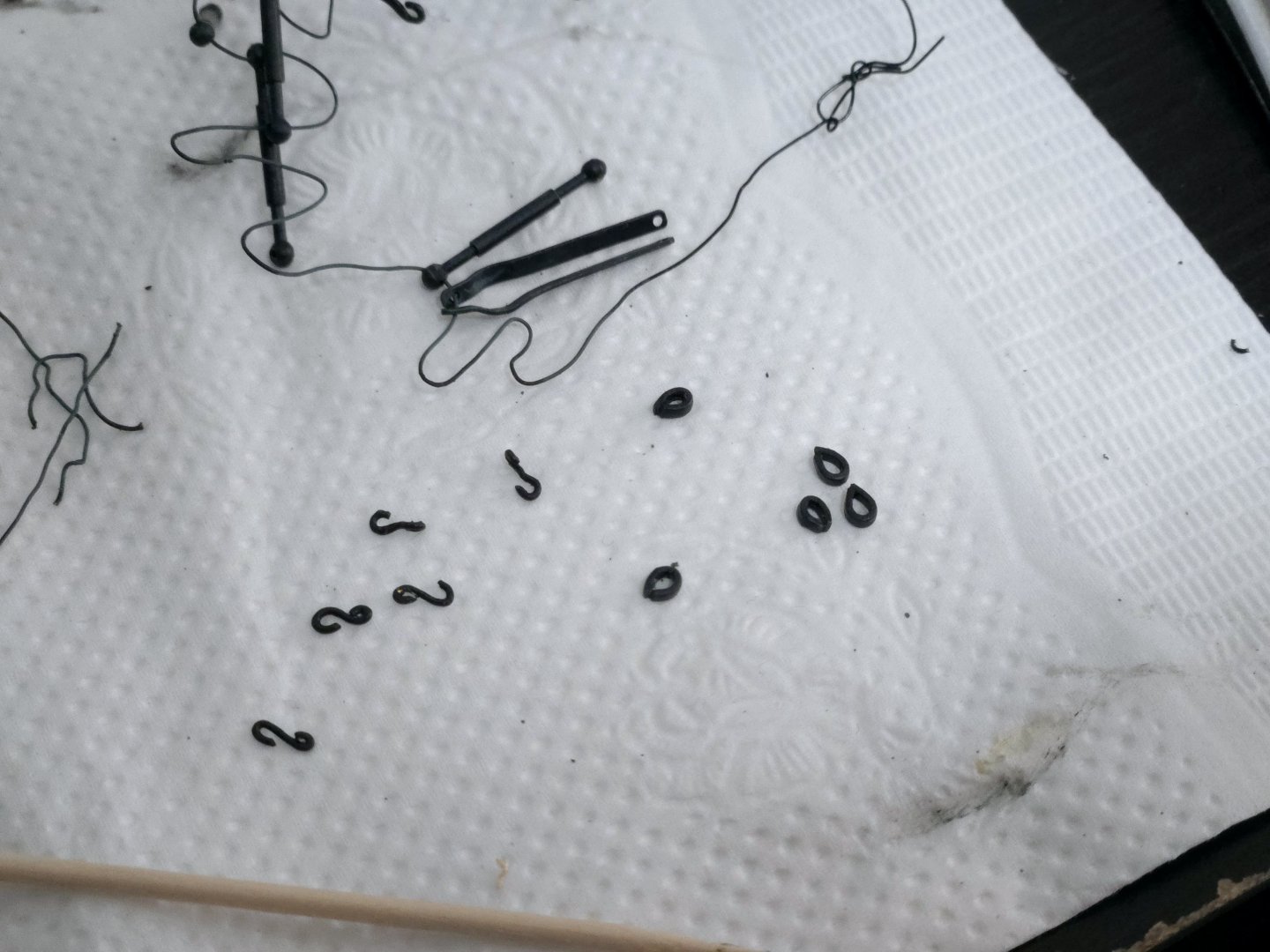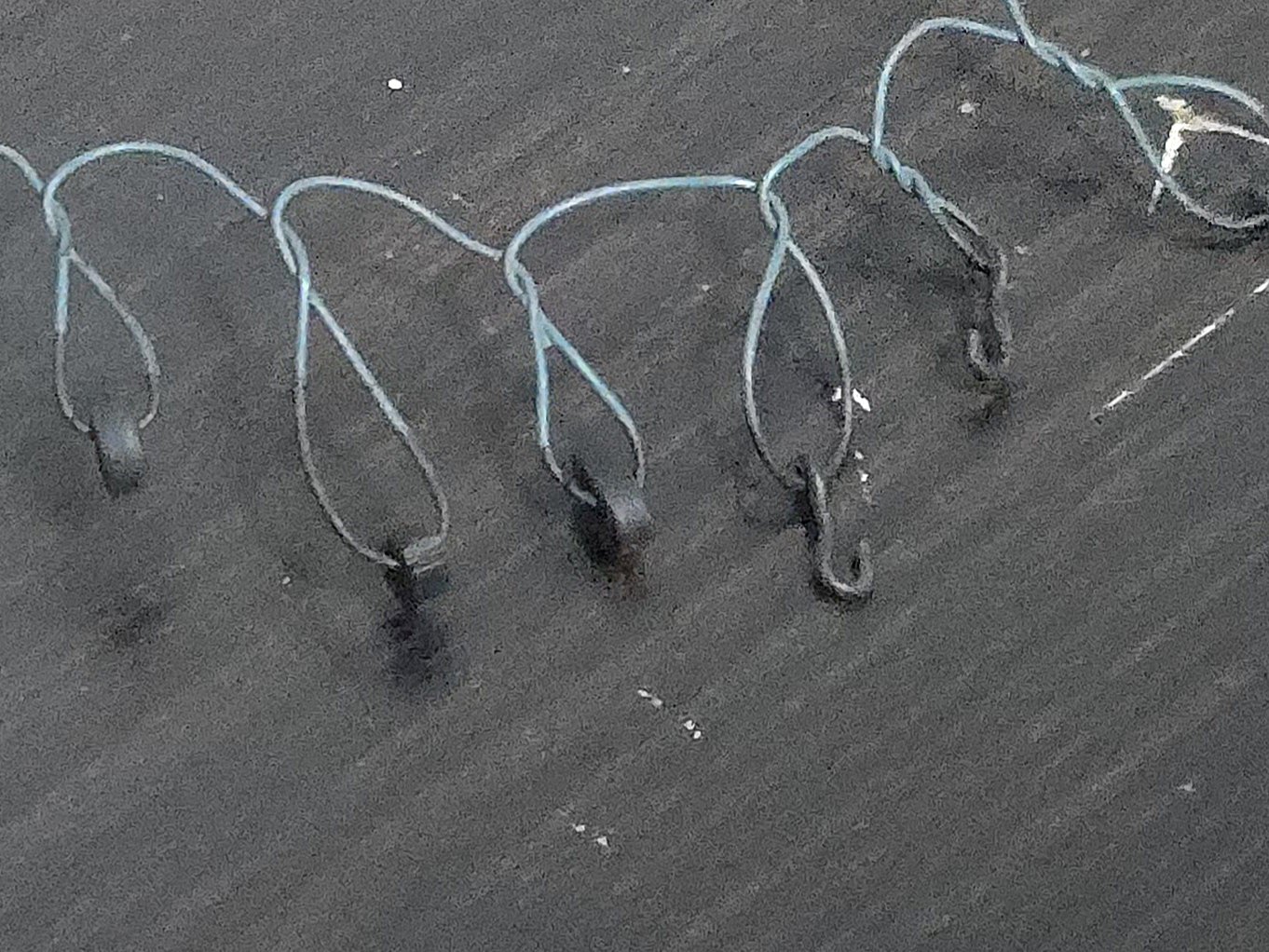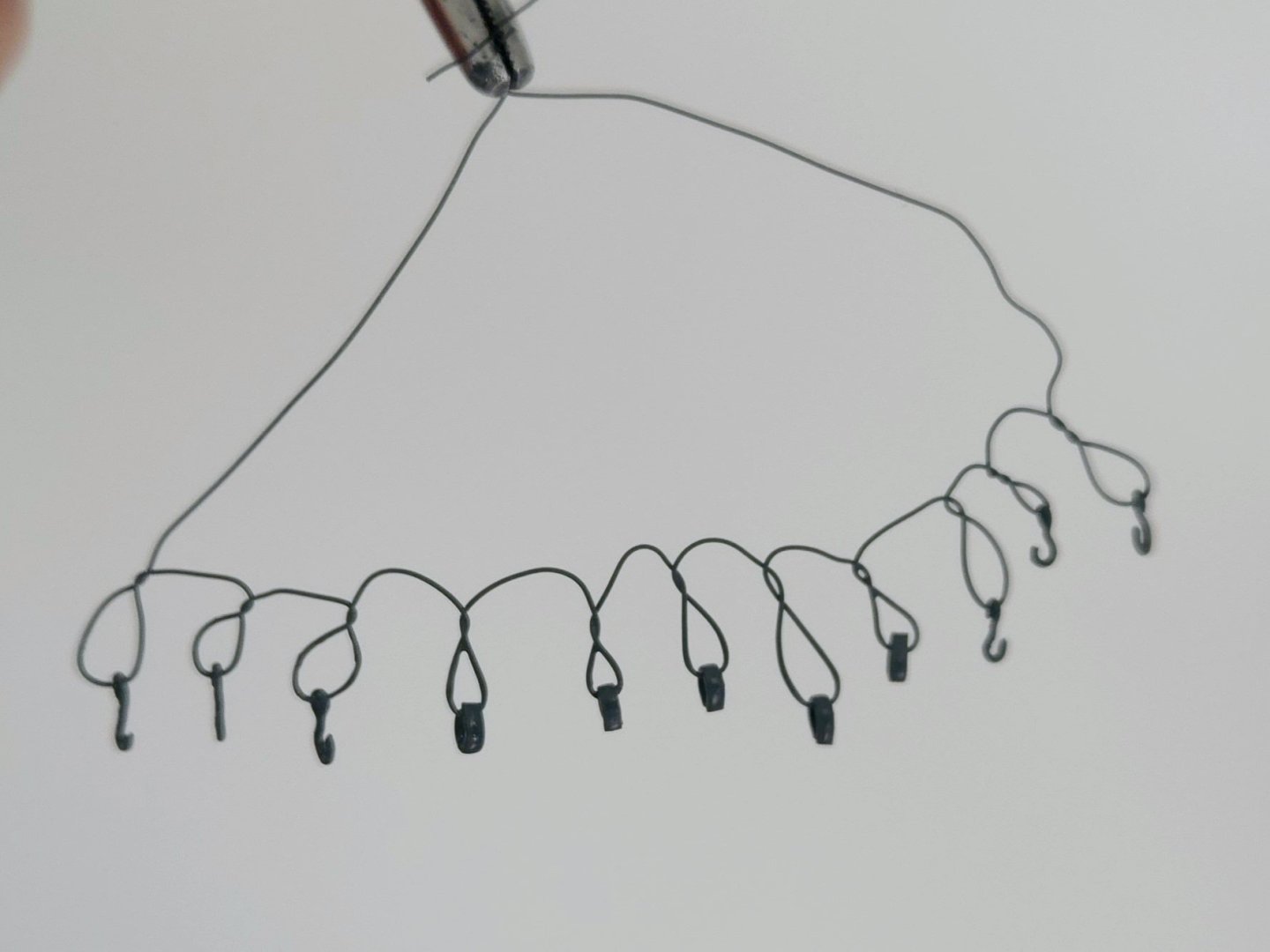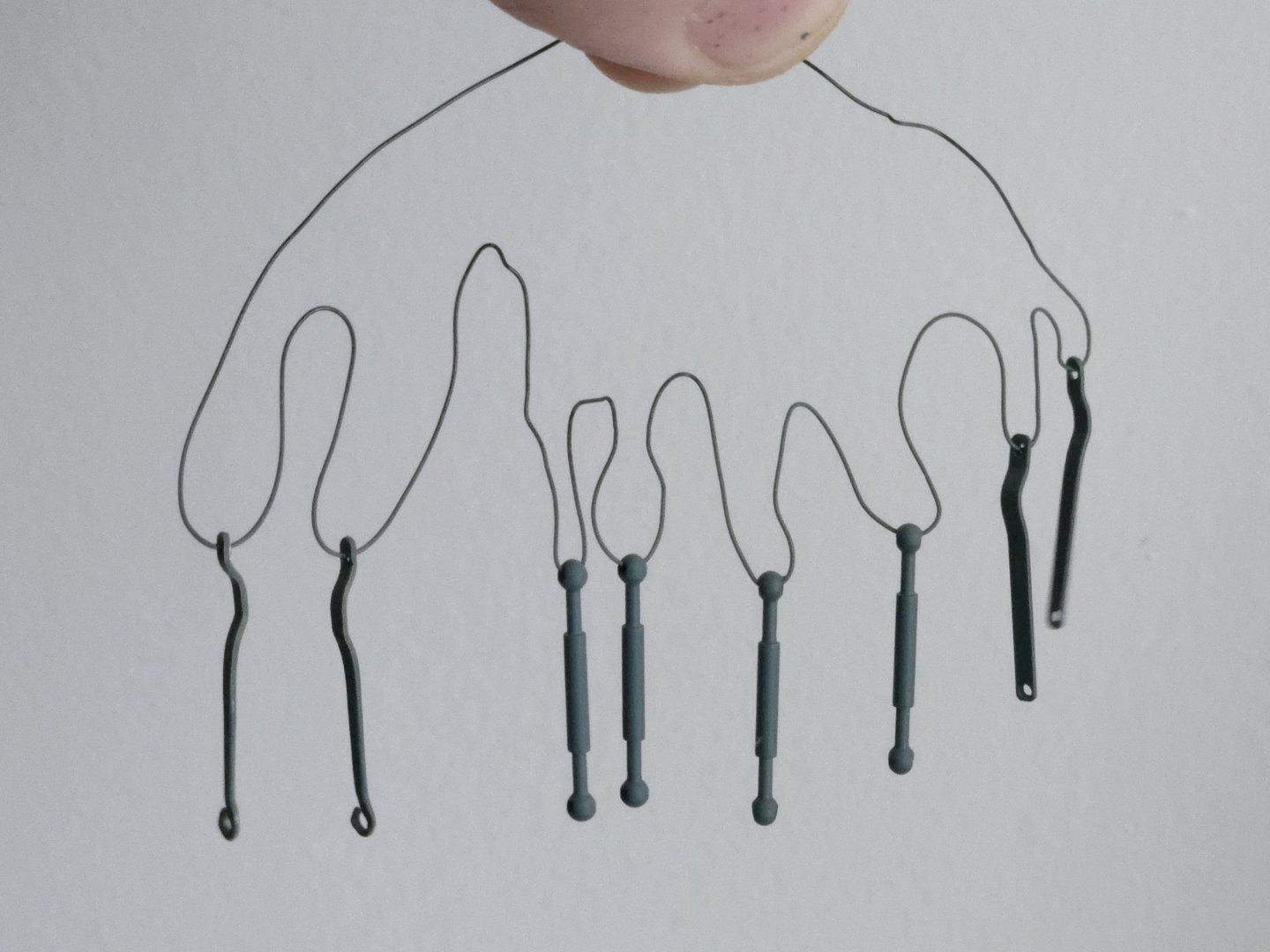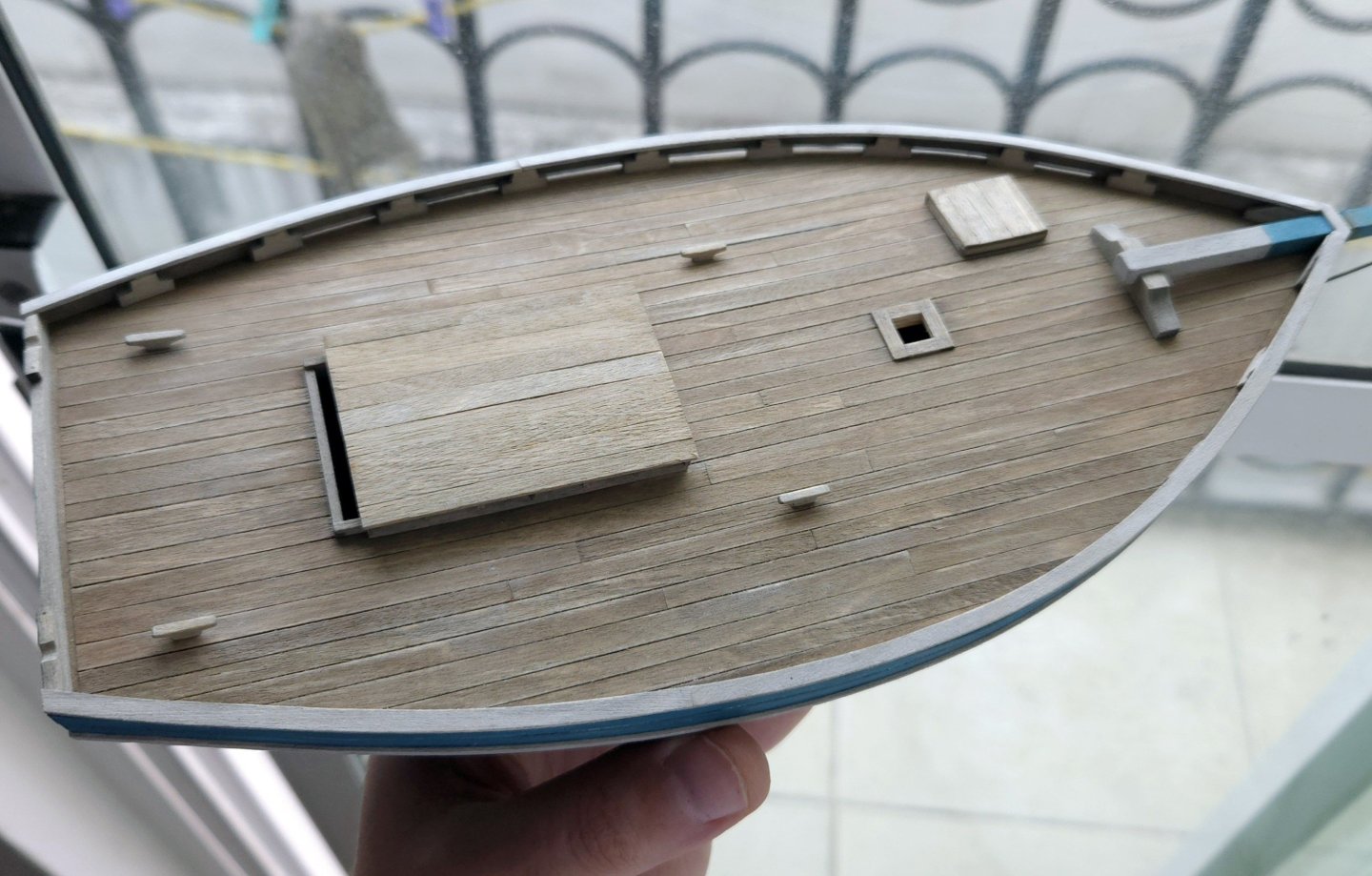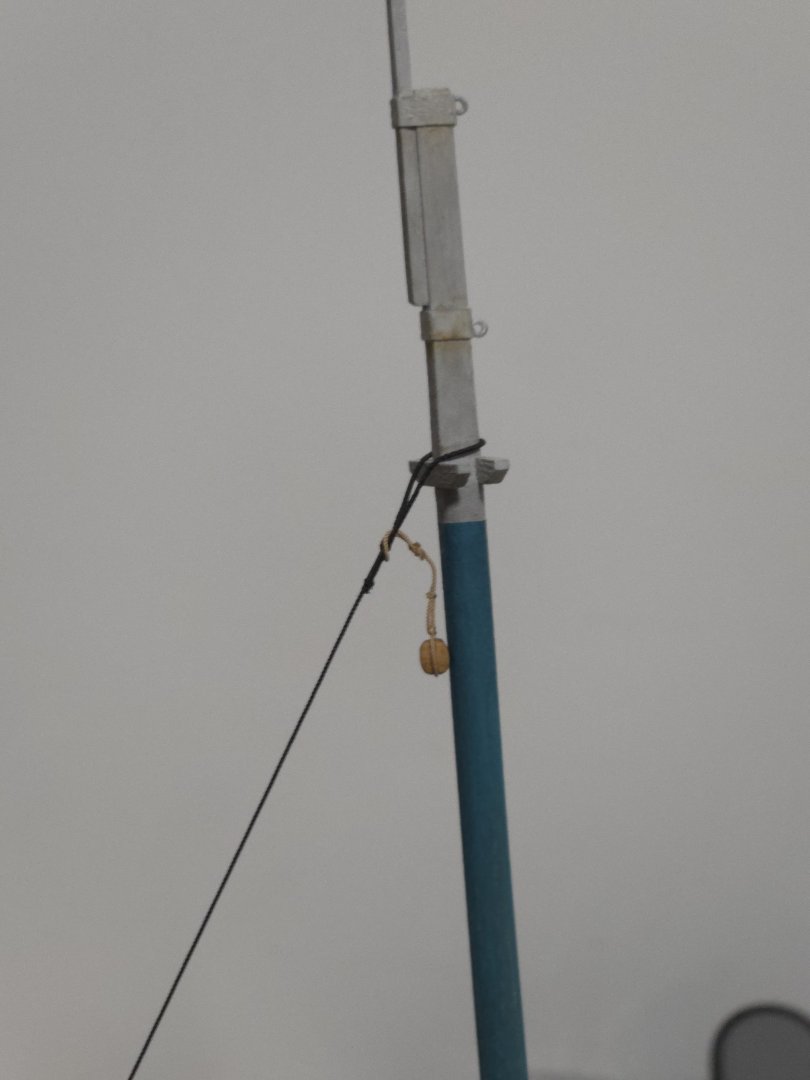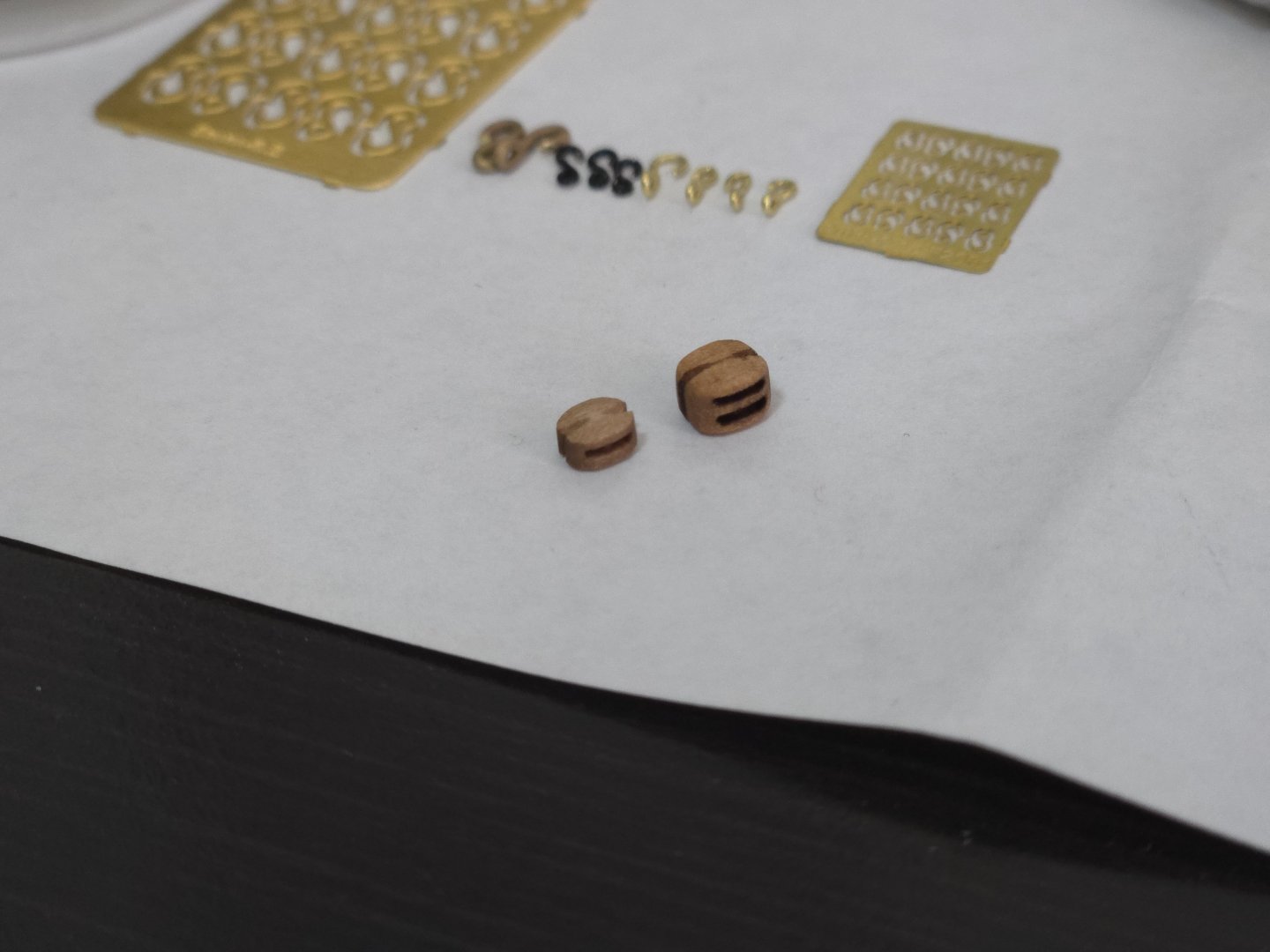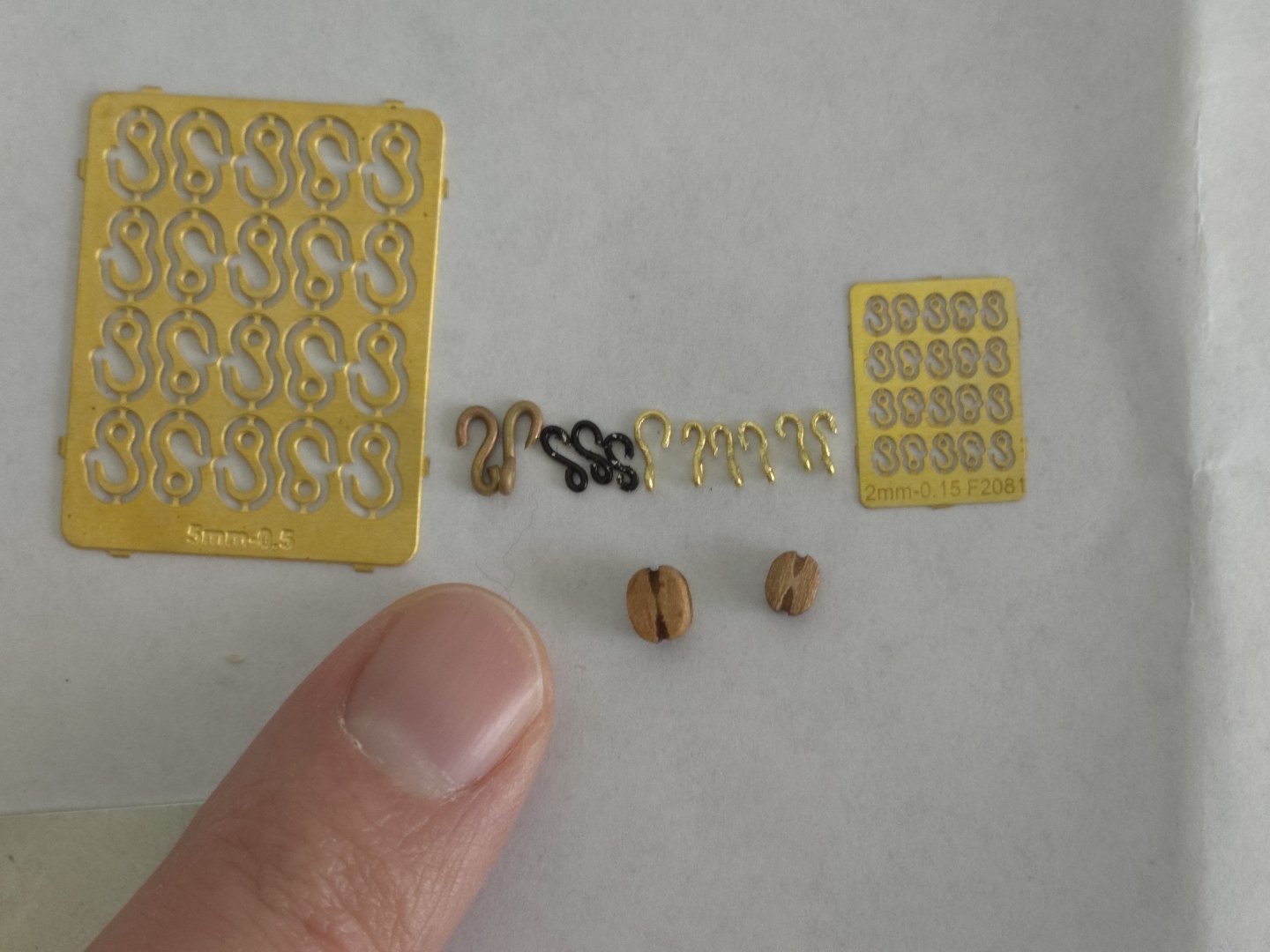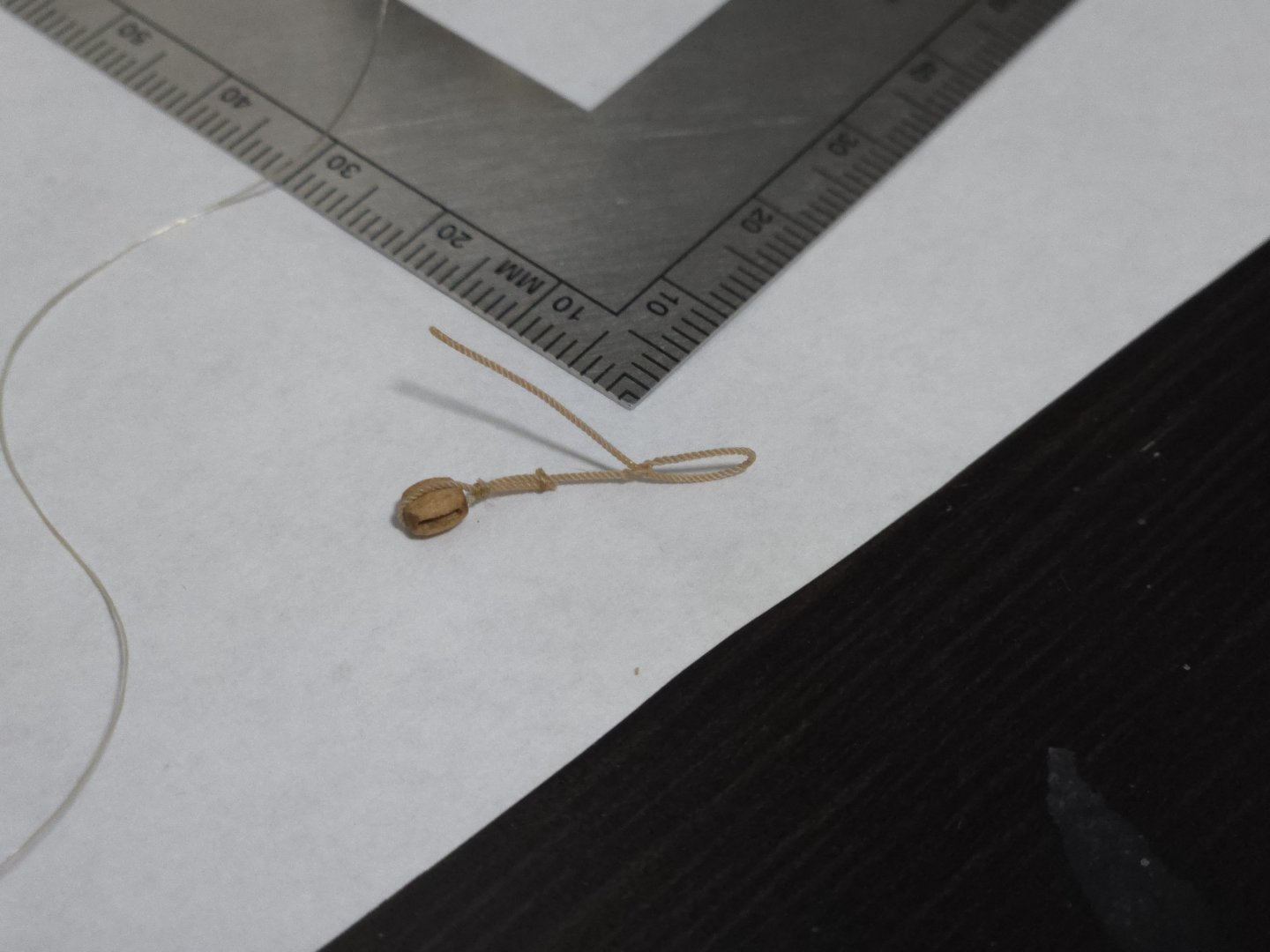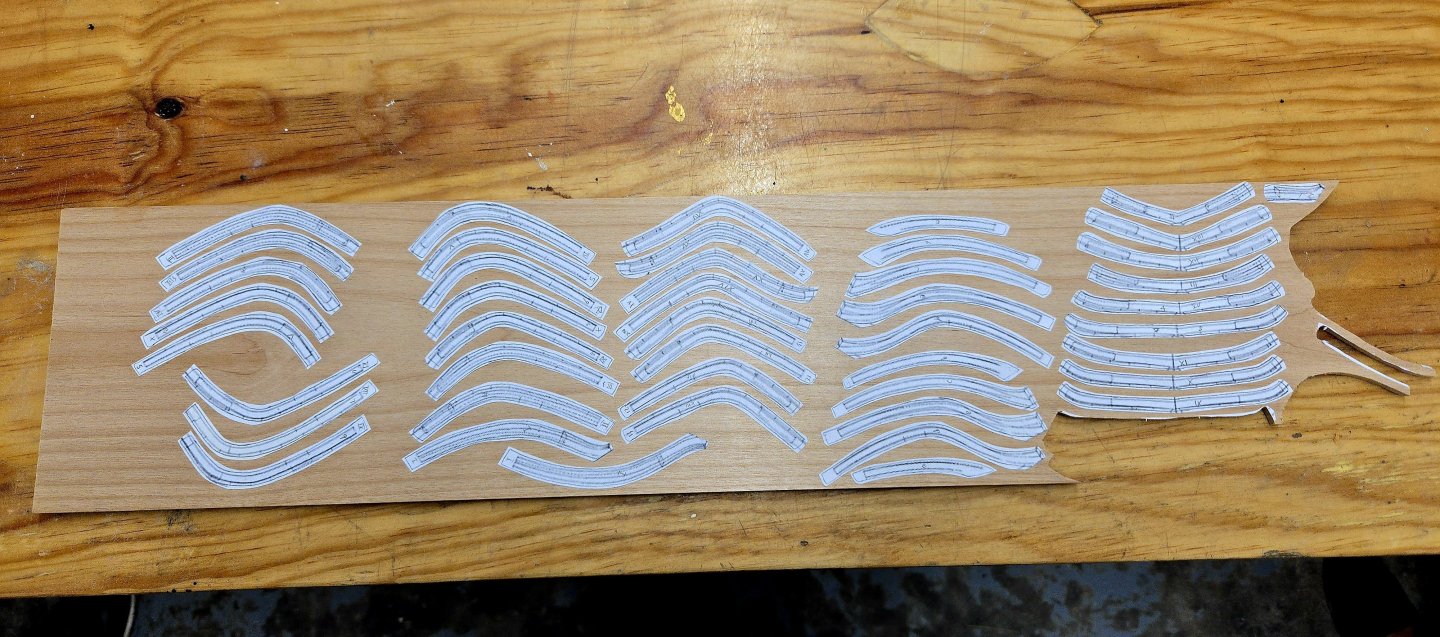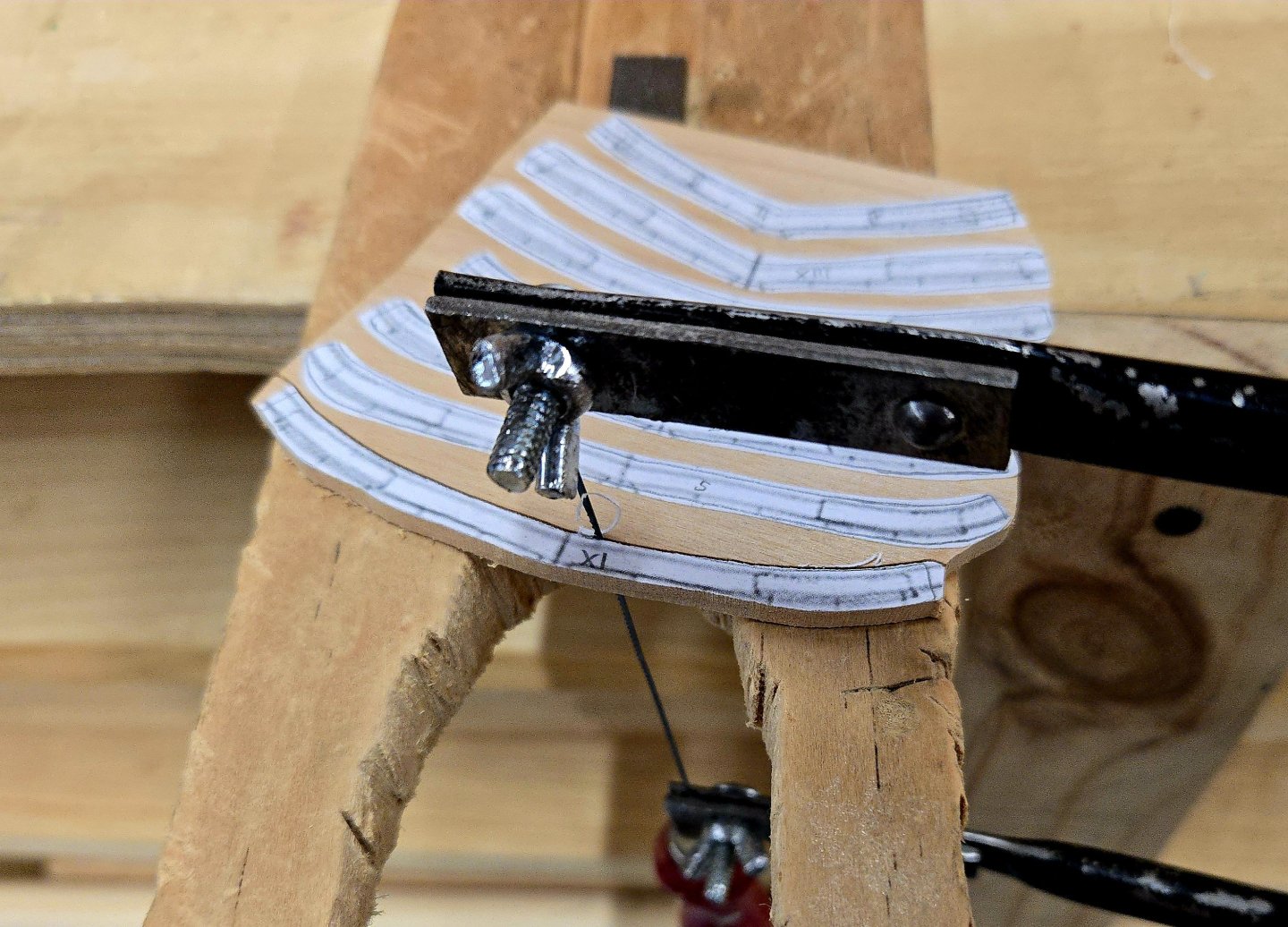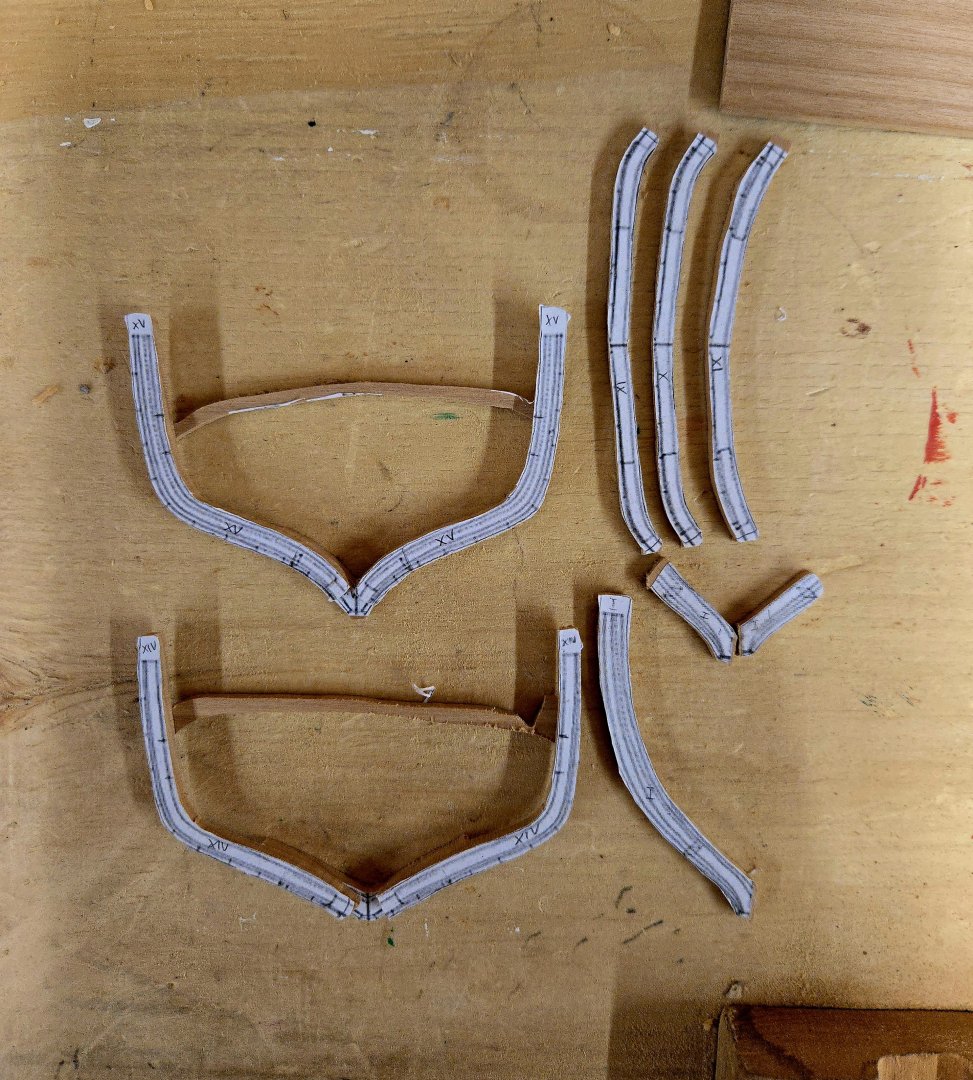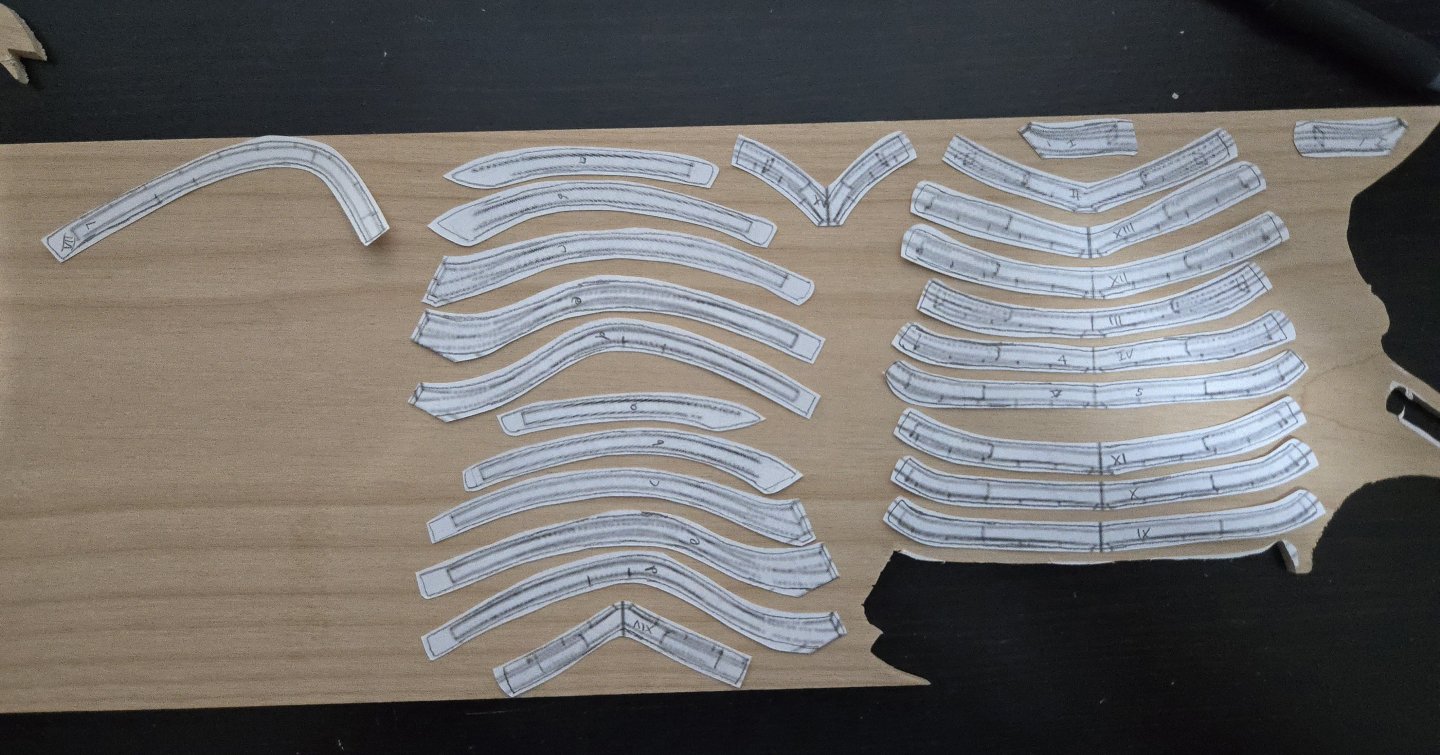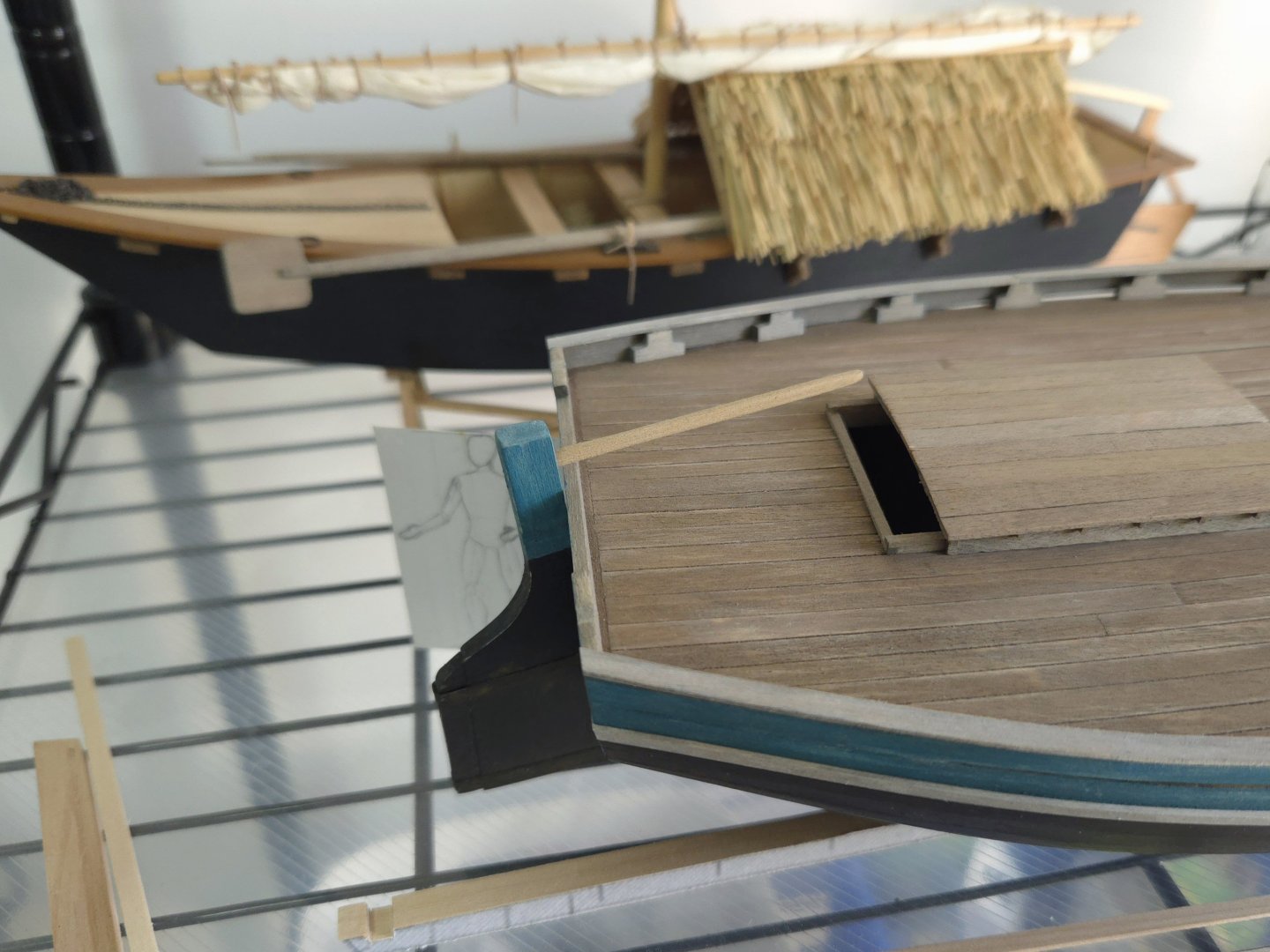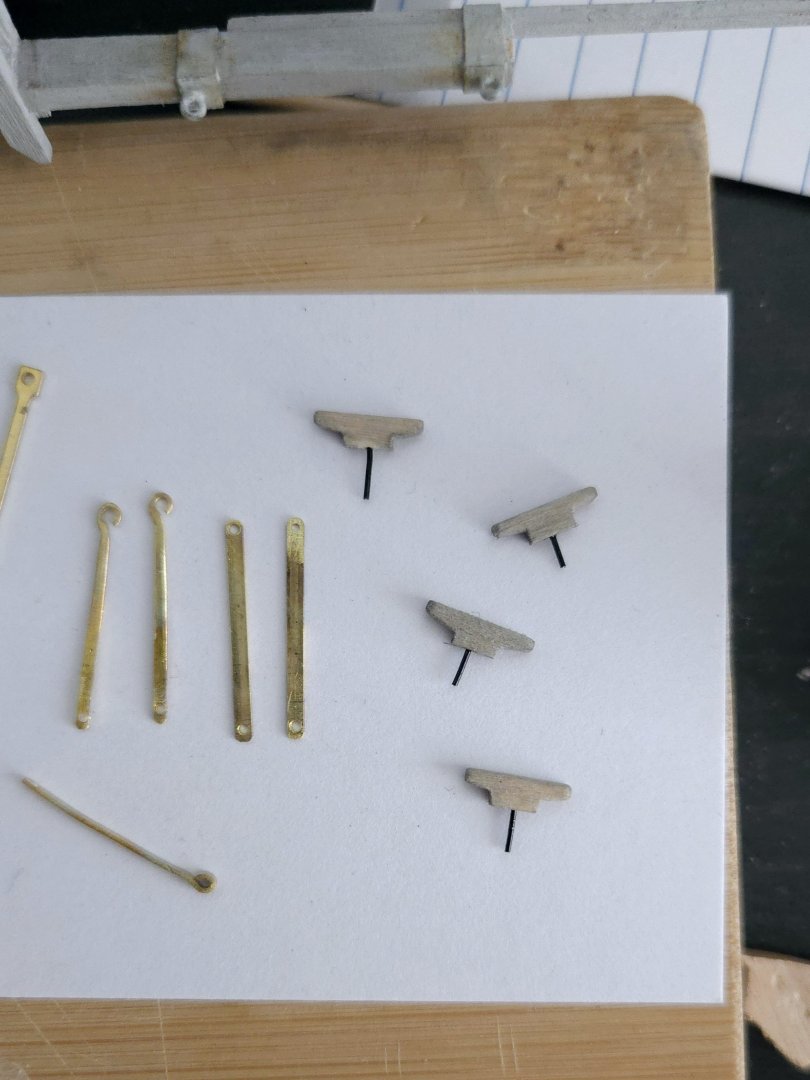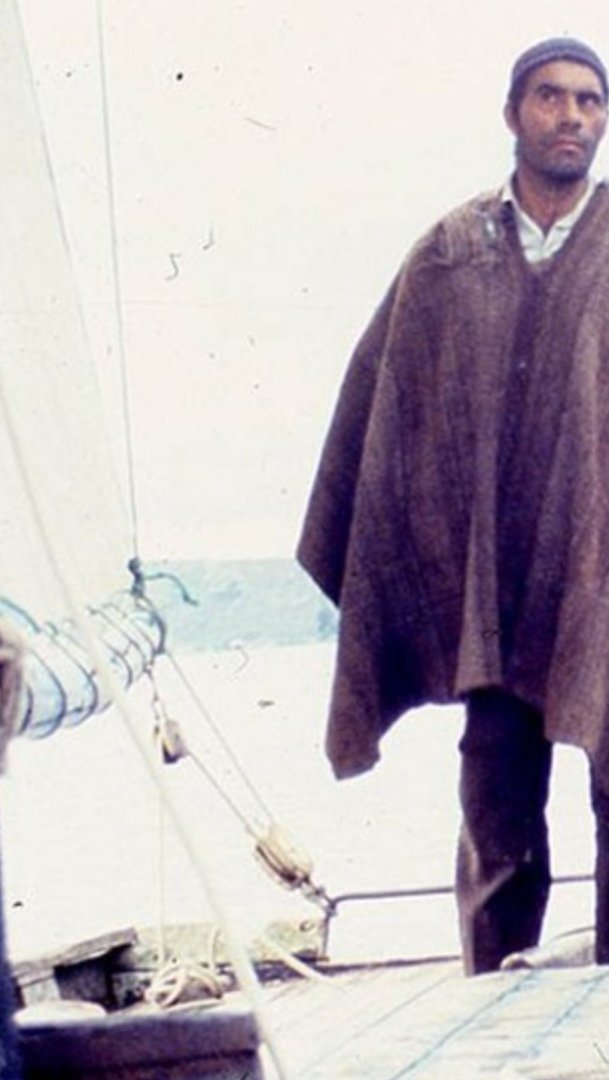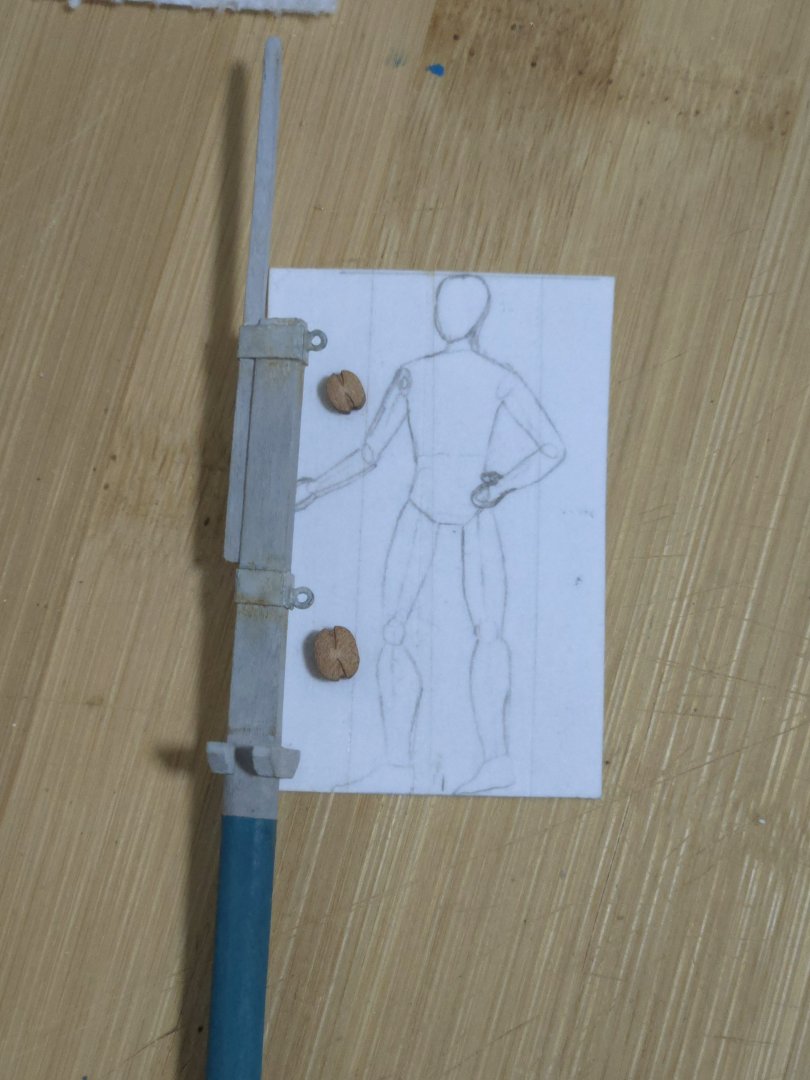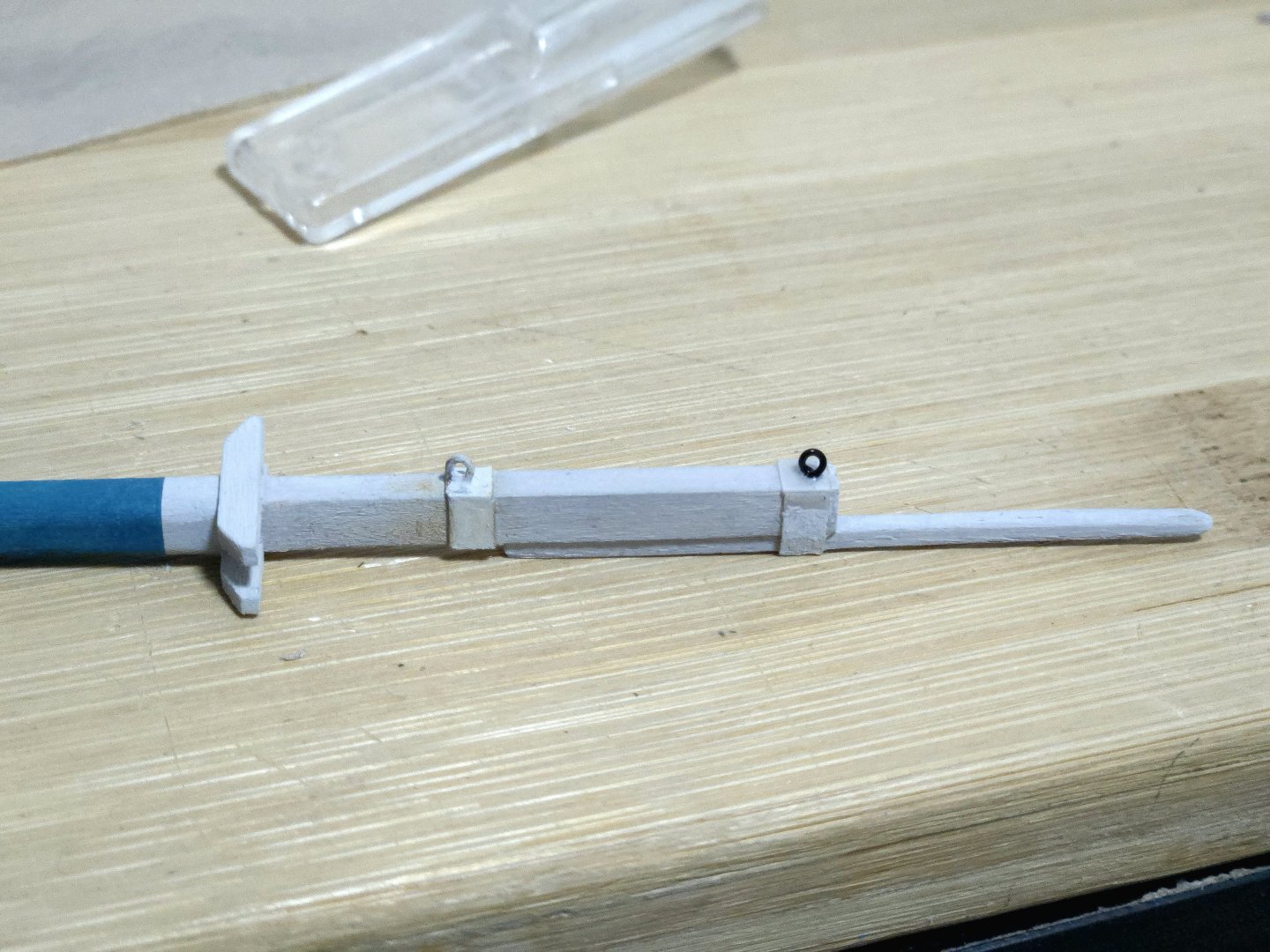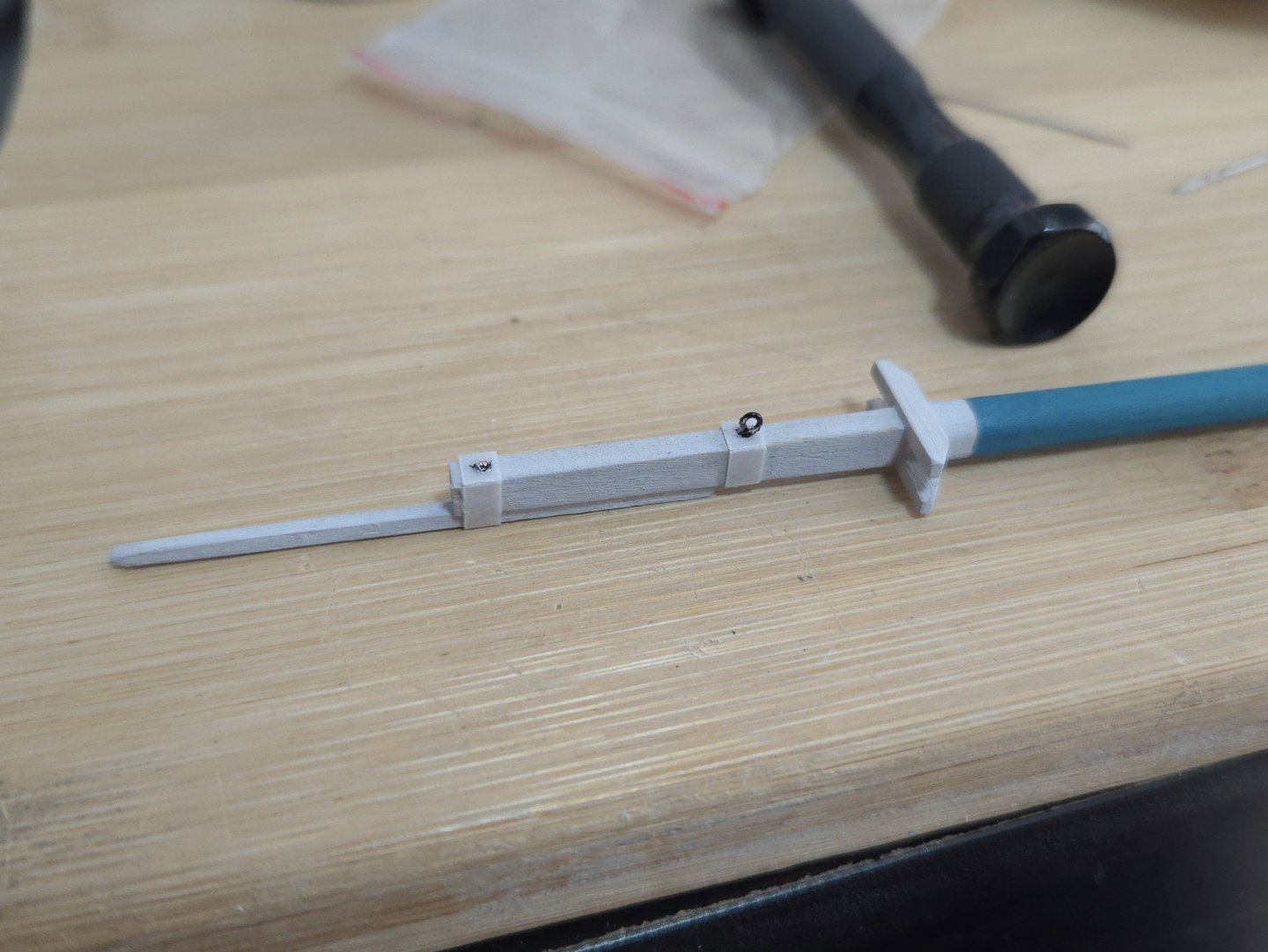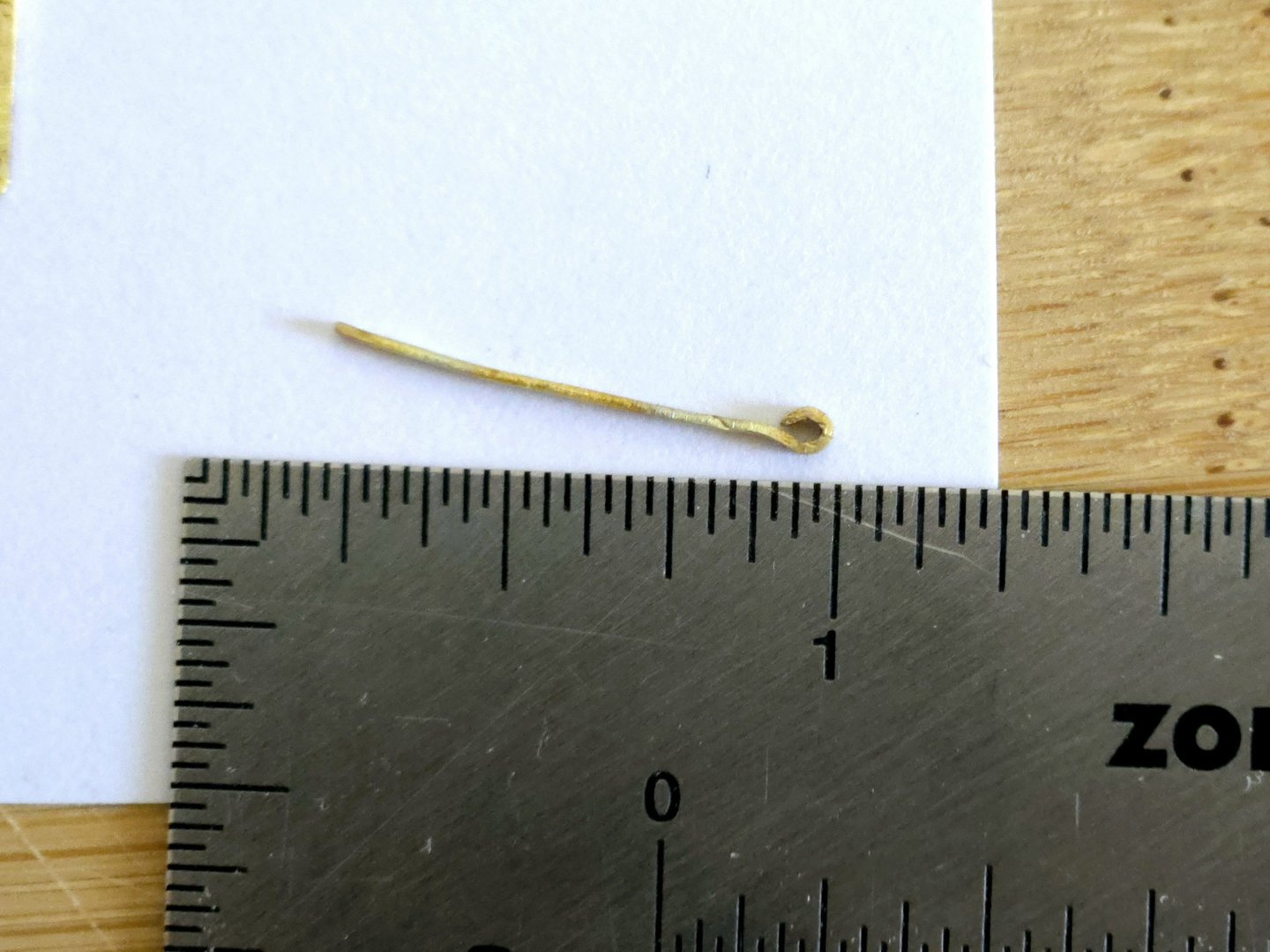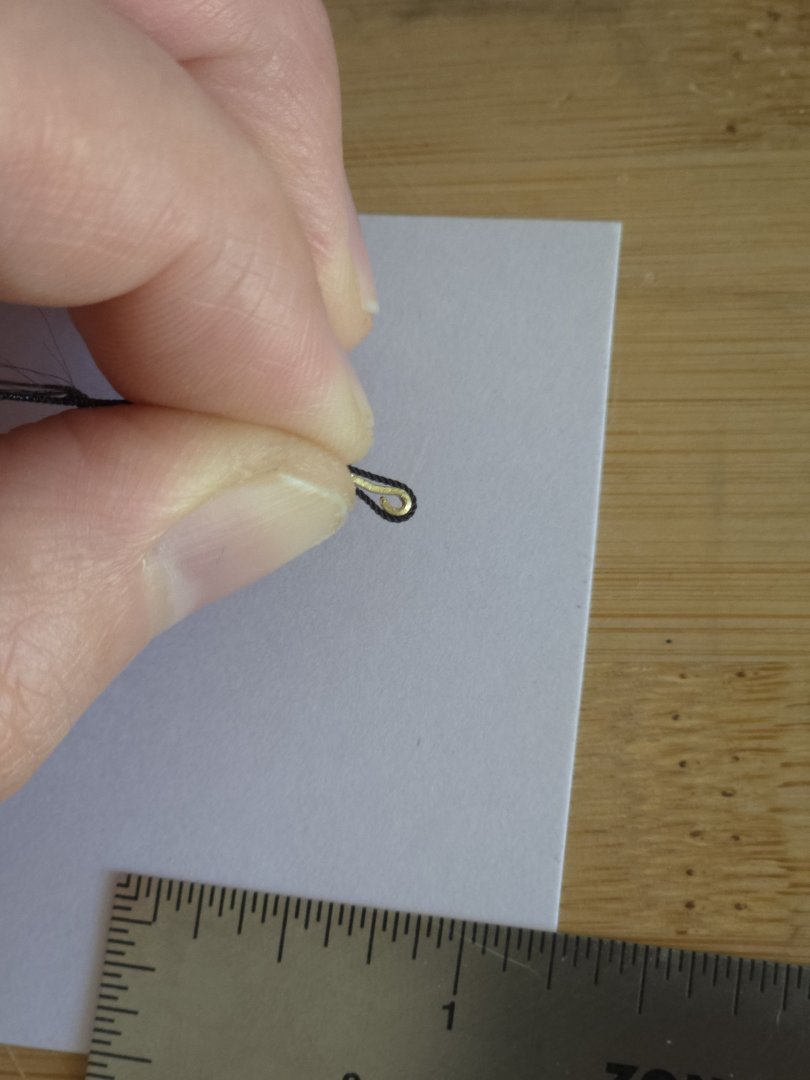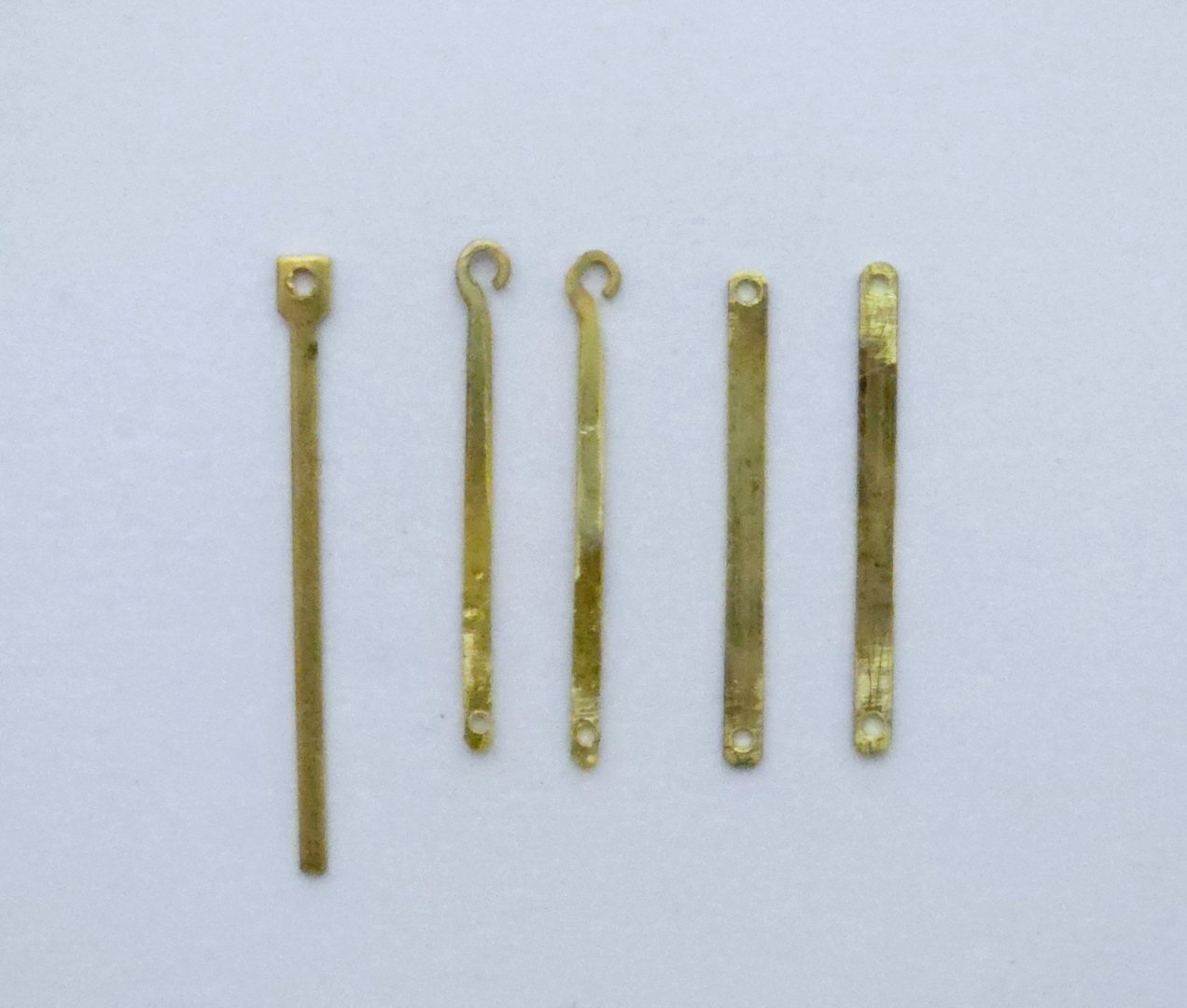-
Posts
1,309 -
Joined
-
Last visited
Content Type
Profiles
Forums
Gallery
Events
Everything posted by JacquesCousteau
-
Nice job! Metal work remains the most difficult part of modeling for me, but it's gotten slightly easier with more practice. Having a bit of thin sheet brass (K&S metals sells a variety and is pretty widely available) on hand to replace and remake parts as needed certainly helps.
- 167 replies
-
- Norwegian Sailing Pram
- Model Shipways
-
(and 1 more)
Tagged with:
-
Thanks! Thanks! I do think I'll taper the aft end a bit before painting. Incidentally the photo you shared shows another detail I'd like to include on the gaff spar, which has been extended slightly (or perhaps it was a repair) at the tip. I think it would add a bit of character to the model.
- 312 replies
-
- Chile
- Latin America
-
(and 6 more)
Tagged with:
-
A bit more progress. First, I stropped the block for the topping lift. I forgot photos, but it's the exact same process as for the peak halyard block, just with a smaller 4mm block (as a number of photos showed smaller blocks for the topping lift). Next, the gaff boom and gooseneck. I had puzzled over exactly how to make this for a while, as none of the photos I could find are very clear on this part. About all I could say for sure is that it wasn't like the goosenecks discussed in John Leather’s The Gaff Rig Handbook, or like those shown in build logs for other vessels--notably, there was clearly no band around the mast. But then I realized that one of José A Garnham's sketches included a side view of a gooseneck arrangement. It clearly shows two eyebolts lined up on the mast, with a hinge of sorts attached to the front of the boom, and a bent rod inserted to allow it to pivot. Source: http://lanchaschilotas.com/wp-content/uploads/2018/01/1MG_2946-2L.jpg (Note: that’s the address for the screenshot. However, the page no longer seems to be up. I’ve noticed several images and pages on Garnham’s lancha chilota site seem to have gone down, unfortunately.) I decided to make this arrangement in the same way as I made the eyebolts in the masthead--using paper for the metal strip on the boom and for a metal base for the eyebolts, and then three wire eyebolts linked with a bit of brass rod. Below, the mast eyebolts are shown. The boom portion, meanwhile, required finally making the boom. After looking at a lot of photos, I decided that a boom roughly half the diameter or so of the mast at its widest point seemed reasonable. I made the boom from some of the same alder sheet I'm using for the Bateau de Lanvéoc's frames, cutting a 5/32-inch wide strip, tapering it, and then rounding it off with a mini plane and sandpaper. I did not do a great job of shaping it and it's very slightly curved if you look down its length, but many booms seem to have been bent slightly like that from their weight and use, so I just arranged the gooseneck eyebolt so it would curve slightly upward. Finally, the metal "key" going through the gooseneck eyebolts was twisted from some brass rod. With that, I was ready for a test fitting. (Of course, many of the parts still need to be painted.) As can be seen, I probably could have stood to position the mast eyebolts slightly closer together--I wanted to leave room for a bit of motion, but this is probably a bit excessive. I'll need to consider whether I want to remove and replace one of the mast eyebolts, or something else, or to just leave it as it is. The gooseneck is functional, though, and I think looks a bit better at a normal distance. As can be seen below, I used simple thread as a rough topping lift and sheet to keep the boom from flopping around too much in test fitting. Besides the gooseneck, I'm also wondering whether the boom should be tapered slightly more. In any case, I'm enjoying this build quite a bit, and am definitely learning a lot from it!
- 312 replies
-
- Chile
- Latin America
-
(and 6 more)
Tagged with:
-
Good luck with your build! Thankfully it's pretty easy to repair most broken parts with glue (especially if the part will be painted), or even to replace parts by tracing and cutting out of scrap wood or a sheet of basswood (which is readily available in craft shops in 1/32‐, 1/16‐, and 3/32-inch thick sheets at a very reasonable price). You've chosen a tricky first model, given that it's single-planked and an open boat, so any errors in the planking will show up on the interior as well. To include photos, you have to click "add files" and add the photos you want. Then you click your cursor where in your text you want the image, and scroll down to click "insert" and it should appear.
- 12 replies
-
- English Pinnace
- Model Shipways
-
(and 2 more)
Tagged with:
-
Nice progress, and great job on the oars, they look excellent! It looks like you've done a lot of good work fairing the hull more than before. That said, I think you may run into trouble around the inner support pieces that the thwarts will rest on. It looks like the support is sticking out a ways beyond some of the frames, which will make planking there difficult unless the instructions say it's supposed to be that way for some reason. Sanding it down even with the frames now will probably save you a big headache later. Also, how high up the bow do the planks extend? If they go too high up, it will be very hard to fit other planks against the stem.
- 51 replies
-
- bounty jolly boat
- Artesania Latina
-
(and 2 more)
Tagged with:
-
After having primed the metal parts, I was able to paint them dark grey with acrylic paint and to add a dash of dry-brushed rust coloration and some pencil marks to highlight certain areas, although the varnish seems to have darkened things slightly. I added the horse rail, making sure to leave room for the tiller. Unfortunately the wood split on the right side while I was test fitting, but I was able to glue it back into place and re-drill the hole (this time using a slightly bigger bit so that the horse wouldn't get stuck). It was then time to try stropping a block with a hook--in this case, the peak halyard block, as I already had a double block stained and ready. Once again, I followed Chuck Passaro's stropping instructions, which I'm finding to be very clear and relatively easy to do, with the modification of doing a few half hitches instead of just wrapping the seizing. I also had some difficulty getting the super glue (which you mostly wipe off immediately) right, as it was very easy to either wipe off too much and have nothing stick, or to not wipe off enough and end up with a shiny spot (which I'll try to take down with a bit of matte varnish). The false splice turned out pretty neat. I'm using .45mm rope from Ropes of Scale for the blocks, and 140-size fly tying thread for the seizings. Sharp-eyed viewers may note that I accidentally used the wrong hook for this--I should have used one with a perpendicular eye instead of twisting the eye of the stropping 90 degrees. Oh well, I think it's hard to notice unless specifically looked for. Now that I finally have the necessary hooks, I'm finding block stropping to be pretty fun. I know this is all pretty basic information to be documenting here, but it's new for me. I'm quickly reaching the point, though, where I'll need to do a bit more woodworking to make the gaff and boom.
- 312 replies
-
- Chile
- Latin America
-
(and 6 more)
Tagged with:
-
Welcome! Having built the dory, and having the lobster smack on my shelf, the model shipways set is a good introduction that will set you up well for more complex kits or for scratchbuilding, if it interests you. If you're interested in fishing and workboats, there are a number of vessel types from Florida history that would make great models, although they'd have to be built from scratch.
-
Thanks Paul! Unfortunately I don't have annealed steel wire, the 24 gauge wire I have has a black plastic coating. I need to pick up some annealed wire soon, it would be a lot stronger and wouldn't require painting. Thanks John! I've now primed the metal parts that I've made so far, after first bending the chainplates into shape. This proved a bit frustrating, as I first tried sticking the hooks and thimbles (the latter of which will go on the ends of the shrouds and forestay) onto a bit of double-sided tape for priming. I didn't realize just how sticky our double-sided tape was, though, and it left a ton of residue. After soaking in alcohol overnight, it still took quite a bit of work to scrape it all off. I ended up instead placing the small parts, like the larger parts, on a loop of 28-gauge wire for priming instead. I also finally added the cleats to the hull, although I still need to add a couple eyebolts with rings and a pair of the blocky double-cleats (not sure if there's an actual term for them) as well to finish up the deck furnishings.
- 312 replies
-
- Chile
- Latin America
-
(and 6 more)
Tagged with:
-
Nice job on the hull, the color scheme looks great! The metal cleats are unfortunate. There are lots of better wooden ones for sale, thankfully, and they aren't hard to make by hand either.
- 34 replies
-
- muscongus bay lobster smack
- Model Shipways
-
(and 1 more)
Tagged with:
-
Thanks, @wefalck and @Thukydides! Your responses are very helpful and make a lot of sense. I decided against serving the strops themselves, as while it may be accurate, it would substantially increase the amount of work to do and would make the stropping thread much harder to work with. I also decided to use hooks to attach blocks to eyebolts, following the examples in photos of the gaff. This required making hooks, which was a bit of a process. Hats off to the many of you who work in smaller scales, making tiny fittings is tricky work! Last year when Crafty Sailor was having its going-out-of-business sale, I picked up two sets of photo-etch hooks in 5mm and 2mm. Looking at them alongside the blocks I have for this build, though, they seemed alternately too big and too small. I tried making a couple hooks from the thinnest brass rod that I have, but found it too difficult to make hooks smaller than 5mm or so due to the thickness of the material. I then tried with 24-gauge wire and was able to get a smaller size, but the coating got very ripped up and they didn't look very good. At that point, I remembered that I had a small bag of eyebolts made of thin brass wire, which worked much better and after a false start resulting in a very oversized hook, I was soon able to make hooks of about 4mm. The hooks are not particularly consistent in shape, but I figure that they're widely spaced enough on the model that it won't be all that noticeable. Below, between the photo-etch hook sets, there are, from left to right, the brass rod hooks, the 24-gauge wire hooks, and then the brass eyebolt hooks, with a 4mm and 5mm block below (and my finger for scale). Of course I only notice now that some of the hooks will need the eye parallel to the hook instead of perpendicular, but that's not a difficult fix before painting. I also did a bit of prep on some blocks. The "beautiful blocks" from ModelExpo look very good to my eyes, but I went to soften some hard edges with fine sandpaper and found that their wood is actually a lighter color than they appear (presumably they look darker because of laser char or some other effect of the manufacturing process). So, I sanded one lightly on all sides, and then stained with minwax golden oak. Below, the 4mm single block has been left untouched, while the 5mm double block was sanded and stained. I think it's a subtle difference, but a nice one. I also did a bit more work on the rigging, this time focusing on the forestay. I began by serving a length of black line. Once I reached the desired length, I secured the end of the serving, but didn't snip it off. Instead, I did a false slice through the opposite end of the served area, forming a served loop, as seen below. The idea was to then continue serving around the splice and a bit down the stay. Unfortunately it didn't work out. My set of helping hands seems to be getting a little loser, despite tightening the screws, and while I've been able to serve straight lengths of line ok, it was impossible to serve around the splice. The rope, which was doubled on the loop side, kept wrapping around itself instead of letting the serving wrap around it, and it became very difficult to maintain tension. I had to stop. So instead, I decided to go for a simpler method of using a couple of seizings to make the loop in served black rope, as seen below. Finally, I did the jib halyard block in the way that Wefalck suggested several posts ago. I used a 4mm block (sanded and stained) as several photos seem to show a smaller block, relative to the gaff halyards, in this location. To strop it, I followed the instructions that Chuck Passaro recently posted on Syren's blocks page, finding it to be clear and easy to follow. The only change was that I ended up using a few half-hitches instead of just wrapping the seizing thread, as I found it hard to maintain pressure otherwise. After stropping the block into place, I did a false splice at the other end to create a loop to fit around the forestay. I then trimmed it and tried to serve around the splice, which was a bit difficult and didn't turn out very smooth. I still found the result acceptable, though. Below, in an unfortunately blurry photo, the forestay has been temporarily put in place, as has the jib halyard block, which will look better once the halyard puts a bit of pressure on it so it doesn't try to pop upward. I think I'll make the gaff throat halyard in the same way, just larger so it loops around the masthead. I'm debating whether I should serve the masthead loop, though--I think I should--and whether that serving should be black or brown. Probably black to match the shroud and forestay serving, although those are meant to be wire while the throat halyard block stropping will be rope.
- 312 replies
-
- Chile
- Latin America
-
(and 6 more)
Tagged with:
-
Thanks, @Keith Black and @gak1965, good to know that I can mix sizes a bit. Looking again at some photos, it does look like at least some lanchas did have varying block sizes. Not much progress on the build at the moment, as I'm finding rigging to be a bit trickier to wrap my head around than I thought. It doesn't help that most sources I've found are for earlier time periods and/or focus on large ocean-going ships. Specifically, I'm stuck on how blocks were joined to eyebolts and the like. If I'm going with rope-stropped blocks, would it make more sense for a block to be tied directly to the eyebolt, or to an eye in the strop on one side of the block and then to use a separate line to join the block eye to the eyebolt? The latter seems more likely for internally stropped blocks, but I'm not sure about rope-stropped blocks. Also, how much of a strop would be served? Thanks in advance for any advice!
- 312 replies
-
- Chile
- Latin America
-
(and 6 more)
Tagged with:
-
I'm looking forward to following along! I've often been curious about how AJ Fisher kits compare to similar ones--Bluejacket seems like the closest comparison. And a Great Lakes schooner is an excellent subject. How do the fittings look? The plans look great, very detailed. Too bad that the display base is warped, though.
- 121 replies
-
- Lucia A Simpson
- AJ Fisher
-
(and 1 more)
Tagged with:
-
I've seen that on some plans, especially near the bow and stern of some coasters in Souvenirs de Marine, it definitely threw me for a moment before I figured it out. The Bateau doesn't have any tumblehome, though, they apparently just decided to draw the top-down view at wale level. After arranging all the frame templates, I felt very relieved to see that I can get all the frames out of a single sheet, leaving an entire extra 5x24-inch sheet for any do-overs. Sawing all these pieces by hand is a bit tedious, so I'll be doing it in portions at a time in the carpentry workshop in between working on a full-scale tv stand. What seems to be working for now is to first saw across the wood sheet cutting the tips of each frame (which I'm leaving long for now). Getting the frames out is then a simple matter of cutting to one edge and then the other. I've also realized that cutting from one side and then the other, meeting in the middle as in the photo below, seems to really reduce the chances of the wood snapping because the frame is only held in place at one of the tips. (Probably an obvious point, but one I hadn't had a chance to learn until this build.) After a while, I had a pair of rough-cut frames (obviously not glued yet), and a few floors and other parts, all ready for final shaping. Given that it will be another week until I'm back in the carpentry workshop and can cut out probably a similar number of frame parts, it's pretty clear that this will be a very slow project.
- 134 replies
-
- ancre
- Bateau de Lanveoc
-
(and 2 more)
Tagged with:
-
Thanks! You are correct, the widths match when checking at the level of the wale. Thank goodness, that would have been quite a problem otherwise. Not any build progress at the moment, just laying out the frame templates--so far the floors and cant frames--on the wood sheet for cutting. After being a bit wasteful cutting the first frames, I'd like to be more efficient and save what wood I can for the inevitable do-overs.
- 134 replies
-
- ancre
- Bateau de Lanveoc
-
(and 2 more)
Tagged with:
-
Cool, looking forward to following your future builds! I also did the Model Shipways Dory credit, even though I had bought it through Amazon as well. I wasn't interested in building the Pram, so they were flexible enough to let me use the credit to get the Midwest Maine Peapod kit instead, along with the Model Shipways Lobster Smack.
-
Thanks, all! A few minor things and a question. I made a simple tiller out of basswood, stained with minwax golden oak and given a dark wash. From what I can tell, the tillers were usually left natural and made of a different, presumably sturdier wood than the deck planking, and so usually weren't as weathered. I also painted the cleats and added pins. Next, the question. I'm trying to figure out whether to use 4mm or 5mm blocks, both of which I have on hand. A photo of both in their positions relative the masthead, and alongside a figure, is below. I've never worked with blocks before, so I don't have a great sense of what will look right. The plans show very tiny blocks that don't look right to me. From poking around, it seems like Steel gives a complex chain of proportions that result in blocks being 8.8 times longer than the rope diameter. I was planning on using .5mm or .6mm rope, which would give blocks either 4.4mm or 5.3mm long. Other sources on similarly-sized boats seem to show a similar range of block sizes (once accounting for scale). Finally, there are photos, such as those below, that look to me to show some larger blocks that look more like the 5mm than the 4mm to me. But other photos from the same source suggest that block size might vary. Source (both photos): https://www.carlosvairo.com/galeria-puerto-montt-lanchas-chilotas So it may make sense to use a 4mm block for the jib halyard, 5mm blocks for the gaff, as they were lifting heavier equipment, and a mix of both on the sheet. But I'm not really sure.
- 312 replies
-
- Chile
- Latin America
-
(and 6 more)
Tagged with:
-
Thanks! That would have been a good way to do it. As it turns out, I ended up just drilling a new hole alongside the previous shank. I had to replace the aft "panel" of the bracket (made of superglue-infused card), which broke in half while attempting to drill. The new eyebolt is slightly above the midpoint, while the eyebolt on the lower bracket is slightly below it, but I'm telling myself that it adds to the versimilitude of a vessel type that often had roughly made or improvised ironwork. The new eyebolt and the surrounding bracket needs to be painted still, like the finished one lower on the masthead.
- 312 replies
-
- Chile
- Latin America
-
(and 6 more)
Tagged with:
-
Thanks, Keith! That might work, but the eyebolt shaft is in pretty deep and pretty tight--even if the superglue dissolves, I don't know if I can get it out.
- 312 replies
-
- Chile
- Latin America
-
(and 6 more)
Tagged with:
-
Thanks! I'm definitely going to need luck on the eyebolt. If drilling it out doesn't work, I may just use a pre-made eyebolt with a straight (rather than twisted) shaft, as it would require a smaller hole. It wouldn't be as strong of a connection, though. Guess we'll see how it goes.
- 312 replies
-
- Chile
- Latin America
-
(and 6 more)
Tagged with:
-
Thanks, @Paul Le Wol! I didn't follow the Cheerful design, but it did get me thinking about filing brass strip into the hook shape. I experimented with some of the Billings chainplates I have on hand. These are somewhat narrower than the brass strip (1mm vs 1/16in), and have a bulkier square end built up around a hole for a pin. Using files and, briefly, a metal cutter, I experimented with shaping the square end into a hook shape, and then carefully drilled through the brass further down for a new pin hole. I'm happy with how they look, although I'm worried that they're fragile around the pin hole. In the photo below, you can see the original Billings chainplate at left, then the two hooked chainplates in the middle (and the normal chainplates to the right). I'm also considering rolling up the Billings chainplates to make the teardrop-shaped metal thimbles that were placed at the ends of the wire shrouds and forestay. They wouldn't have flanges to keep the rope in place, but a drop of glue could pretty easily secure them. It would be something like the test below (although the thimble would of course be cut off from the rest of the strip). Upon looking at more photos, though, I think it should be a bit larger. I've also painted the mast and begun adding the brackets and eyebolts--the metalwork still needs painting. I'm glad that, after painting the hull, I decided to save the blue-green paint in an old pill bottle rather than trying to re-mix it again. Unfortunately, as can be seen below, one of the eyebolts snapped off, leaving the metal shank superglued in the mast. I'll need to either drill this out or drill a new, slightly off-center eyebolt hole. Two other points I'm thinking about now. First, the turnbuckles. While I like how they look with the blackening, if I'm painting the other metal parts, I suppose they, too, should be painted for consistency. Second, the gooseneck has proven difficult to figure out, because it's covered by sails and rigging in most photos. About the only things that are clear are that 1) there was no associated metal bracket around the mast, and 2) there was some sort of pin holding it in place. With this in mind, I'm thinking of putting an eyebolt on the end of the boom (once I get to the boom) and sandwiching it between either two other eyebolts or some brass strip with holes drilled into it. (Also, if anyone has any experience replacing an eyebolt that snapped off, I'm all ears!)
- 312 replies
-
- Chile
- Latin America
-
(and 6 more)
Tagged with:
-
I'm looking forward to following along, especially as I have the same kit on my shelf. Good luck dealing with the challenges and thanks for the heads-up, I'll keep an eye out when I get to mine. Do you think you'll be modifying the kit much? It seems like they present it with some sort of reduced winter rig (which does look quute nice), but the actual vessels could have a larger sail plan. Great car, too!
About us
Modelshipworld - Advancing Ship Modeling through Research
SSL Secured
Your security is important for us so this Website is SSL-Secured
NRG Mailing Address
Nautical Research Guild
237 South Lincoln Street
Westmont IL, 60559-1917
Model Ship World ® and the MSW logo are Registered Trademarks, and belong to the Nautical Research Guild (United States Patent and Trademark Office: No. 6,929,264 & No. 6,929,274, registered Dec. 20, 2022)
Helpful Links
About the NRG
If you enjoy building ship models that are historically accurate as well as beautiful, then The Nautical Research Guild (NRG) is just right for you.
The Guild is a non-profit educational organization whose mission is to “Advance Ship Modeling Through Research”. We provide support to our members in their efforts to raise the quality of their model ships.
The Nautical Research Guild has published our world-renowned quarterly magazine, The Nautical Research Journal, since 1955. The pages of the Journal are full of articles by accomplished ship modelers who show you how they create those exquisite details on their models, and by maritime historians who show you the correct details to build. The Journal is available in both print and digital editions. Go to the NRG web site (www.thenrg.org) to download a complimentary digital copy of the Journal. The NRG also publishes plan sets, books and compilations of back issues of the Journal and the former Ships in Scale and Model Ship Builder magazines.





